Intermec Technologies CK3DHIB CK3 Series Handheld Computer User Manual 935 016 001
Intermec Technologies Corporation CK3 Series Handheld Computer 935 016 001
Contents
- 1. Compliance Info 1
- 2. Compliance Insert
- 3. User Manual
- 4. Final User Manual
Final User Manual
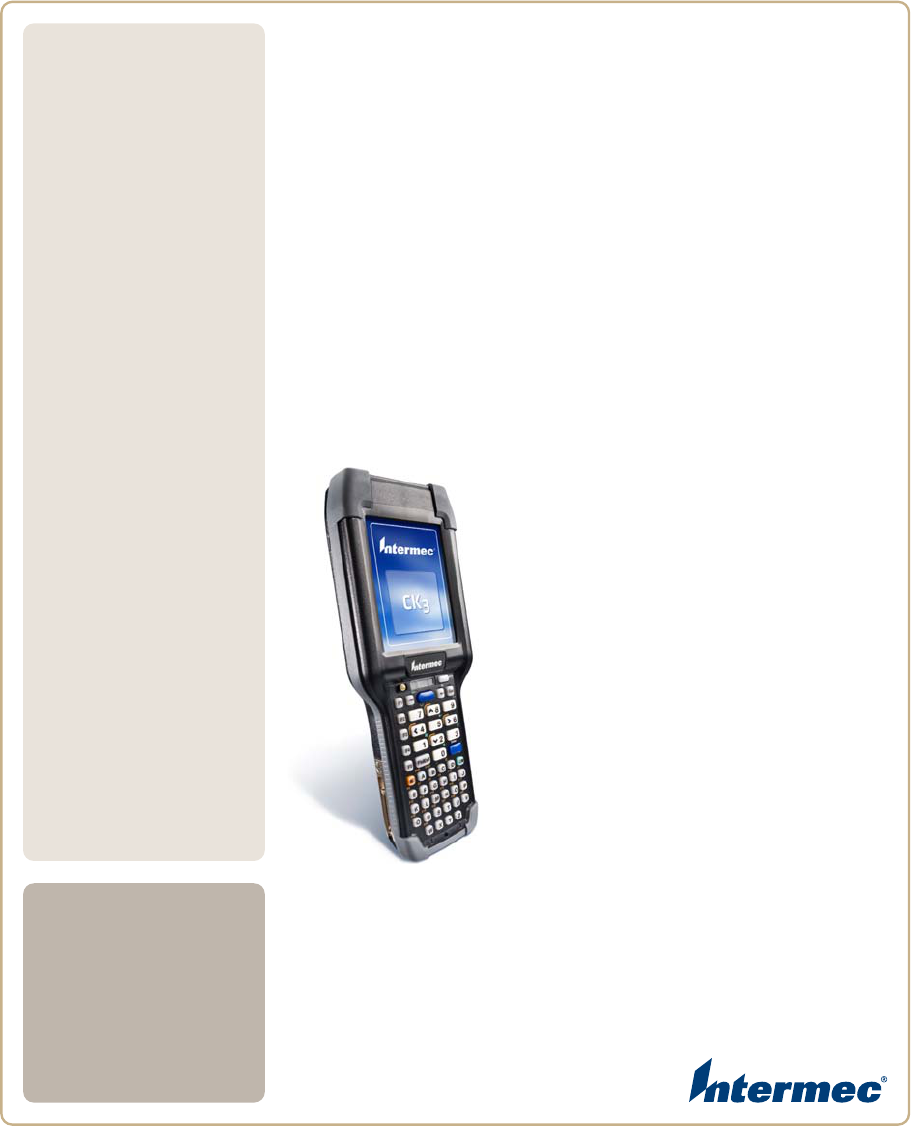
CK3Mobile Computer
CK3a, CK3n
User’s
Manual
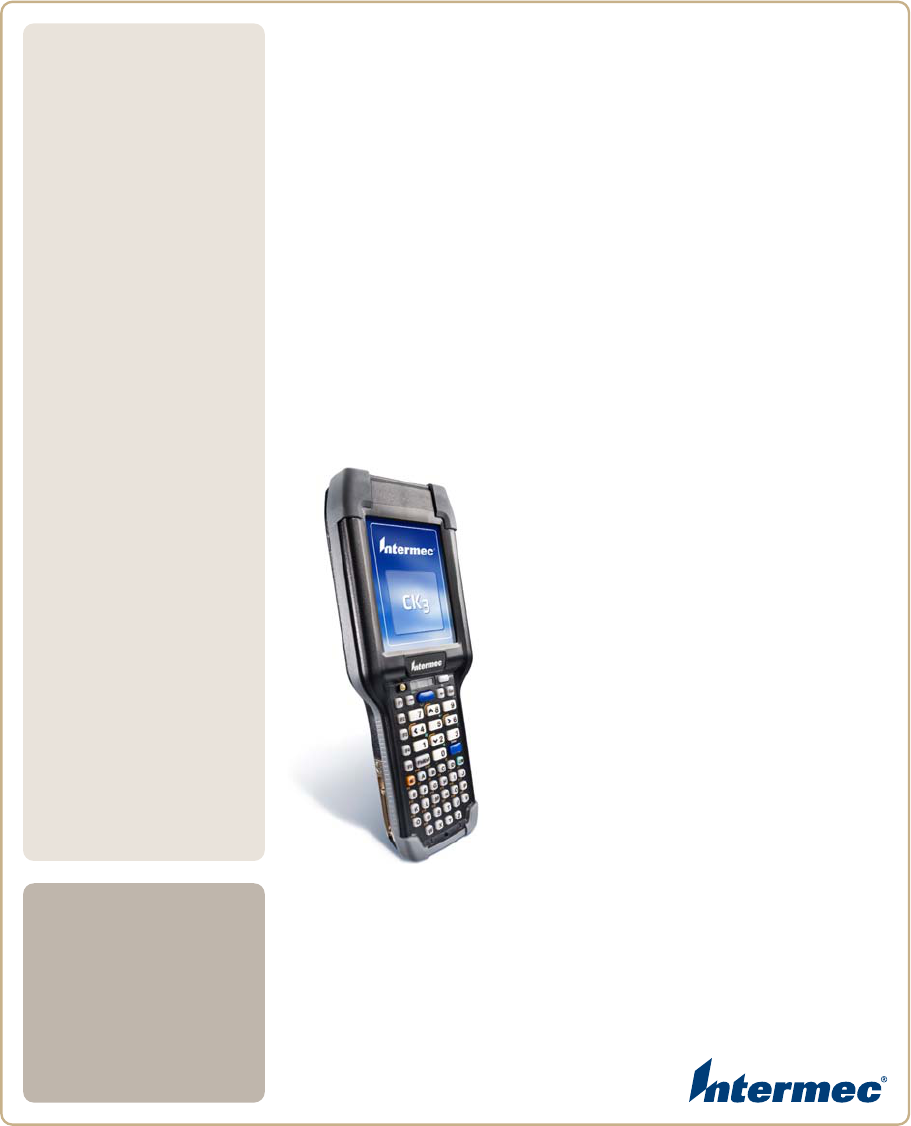
CK3Mobile Computer
CK3a, CK3n
User’s
Manual
ii CK3 Mobile Computer User’s Manual
Intermec Technologies Corporation
Worldwide Headquarters
6001 36th Ave.W.
Everett, WA 98203
U.S.A.
www.intermec.com
The information contained herein is provided solely for the purpose of allowing customers to
operate and service Intermec-manufactured equipment and is not to be released, reproduced, or
used for any other purpose without written permission of Intermec Technologies Corporation.
Information and specifications contained in this document are subject to change without prior
notice and do not represent a commitment on the part of Intermec Technologies Corporation.
© 2008 by Intermec Technologies Corporation. All rights reserved.
The word Intermec, the Intermec logo, Norand, ArciTech, Beverage Routebook, CrossBar,
dcBrowser, Duratherm, EasyADC, EasyCoder, EasySet, Fingerprint, i-gistics, INCA (under license),
Intellitag, Intellitag Gen2, JANUS, LabelShop, MobileLAN, Picolink, Ready-to-Work, RoutePower,
Sabre, ScanPlus, ShopScan, Smart Mobile Computing, SmartSystems, TE 2000, Trakker Antares,
and Vista Powered are either trademarks or registered trademarks of Intermec Technologies
Corporation.
There are U.S. and foreign patents as well as U.S. and foreign patents pending.
Wi-Fi is a registered certification mark of the Wi-Fi Alliance.
Microsoft, Windows, and the Windows logo are registered trademarks of Microsoft Corporation
in the United States and/or other countries.
Bluetooth is a trademark of Bluetooth SIG, Inc., U.S.A.
This product includes software developed by the OpenSSL Project for use in the OpenSSL Toolkit
(www.openssl.org).
This product includes cryptographic software written by Eric Young (EAY@cryptsoft.com).
This product uses Regex++, Index software during its operational phases. The owner of Regex++
has granted use of the software to anyone provided such use is accompanied by the following
copyright and permission notice:
Regex++, Index. (Version 3.31, 16th Dec 2001)
Copyright © 1998-2001 Dr John Maddock
Permission to use, copy, modify, distribute and sell this software and its documentation for any
purpose is hereby granted without fee, provided that the above copyright notice appear in all
copies and that both that copyright notice and this permission notice appear in supporting
documentation. Dr John Maddock makes no representations about the suitability of this software
for any purpose. It is provided “as is” without express or implied warranty.
iTalkie is a trademark of TABLETmedia, Inc.
Contents
CK3 Mobile Computer User’s Manual iii
Contents
Before You Begin. . . . . . . . . . . . . . . . . . . . . . . . . . . . . . . . . . . . . . . . . . . . . . . . . . . . . . . . . . . . . . . . . vii
Safety Information . . . . . . . . . . . . . . . . . . . . . . . . . . . . . . . . . . . . . . . . . . . . . . . . . . . . . . . vii
Global Services and Support . . . . . . . . . . . . . . . . . . . . . . . . . . . . . . . . . . . . . . . . . . . . . . vii
Warranty Information. . . . . . . . . . . . . . . . . . . . . . . . . . . . . . . . . . . . . . . . . . . . vii
Web Support . . . . . . . . . . . . . . . . . . . . . . . . . . . . . . . . . . . . . . . . . . . . . . . . . . . viii
Telephone Support . . . . . . . . . . . . . . . . . . . . . . . . . . . . . . . . . . . . . . . . . . . . . viii
Service Location Support . . . . . . . . . . . . . . . . . . . . . . . . . . . . . . . . . . . . . . . . viii
Who Should Read This Manual . . . . . . . . . . . . . . . . . . . . . . . . . . . . . . . . . . . . . . . . . . . ix
Related Documents . . . . . . . . . . . . . . . . . . . . . . . . . . . . . . . . . . . . . . . . . . . . . . . . . . . . . . ix
Patent Information . . . . . . . . . . . . . . . . . . . . . . . . . . . . . . . . . . . . . . . . . . . . . . . . . . . . . . . x
1 Using the Computer . . . . . . . . . . . . . . . . . . . . . . . . . . . . . . . . . . . . . . . . . . . . . . . . . . . . . 1
Introducing the CK3 Mobile Computer . . . . . . . . . . . . . . . . . . . . . . . . . . . . . . . . . . . . . . . . . . . . . 2
Using the Battery . . . . . . . . . . . . . . . . . . . . . . . . . . . . . . . . . . . . . . . . . . . . . . . . . . . . . . . . . . . . . . . . . 3
Charging the Battery . . . . . . . . . . . . . . . . . . . . . . . . . . . . . . . . . . . . . . . . . . . . . . . . . . . . . .4
Removing and Installing the Battery. . . . . . . . . . . . . . . . . . . . . . . . . . . . . . . . . . . . . . . . 4
Maximizing Battery Life . . . . . . . . . . . . . . . . . . . . . . . . . . . . . . . . . . . . . . . . . . . . . . . . . . . 5
Checking the Battery Status . . . . . . . . . . . . . . . . . . . . . . . . . . . . . . . . . . . . . . . . . . . . . . . 6
Using the Keypad . . . . . . . . . . . . . . . . . . . . . . . . . . . . . . . . . . . . . . . . . . . . . . . . . . . . . . . . . . . . . . . . . 7
Using the Color-Coded Keys . . . . . . . . . . . . . . . . . . . . . . . . . . . . . . . . . . . . . . . . . . . . . . . 8
Capitalizing Characters. . . . . . . . . . . . . . . . . . . . . . . . . . . . . . . . . . . . . . . . . . . . . . . . . . . . 9
Using the Power Button . . . . . . . . . . . . . . . . . . . . . . . . . . . . . . . . . . . . . . . . . . . . . . . . . . . 9
Configuring the Backlight Settings . . . . . . . . . . . . . . . . . . . . . . . . . . . . . . . . . . . . . . . . . 9
Understanding the Audio Features . . . . . . . . . . . . . . . . . . . . . . . . . . . . . . . . . . . . . . . . . . . . . . . .10
Adjusting the Volume of the Speaker . . . . . . . . . . . . . . . . . . . . . . . . . . . . . . . . . . . . . .10
Using the Push To Talk (PTT) Feature . . . . . . . . . . . . . . . . . . . . . . . . . . . . . . . . . . . . .10
Recording Audio on Your CK3 . . . . . . . . . . . . . . . . . . . . . . . . . . . . . . . . . . . .11
Using Your CK3 as a Two-Way Radio . . . . . . . . . . . . . . . . . . . . . . . . . . . . . . 11
Using the Touch Screen . . . . . . . . . . . . . . . . . . . . . . . . . . . . . . . . . . . . . . . . . . . . . . . . . . . . . . . . . .12
Using the Stylus . . . . . . . . . . . . . . . . . . . . . . . . . . . . . . . . . . . . . . . . . . . . . . . . . . . . . . . . . 12
Understanding the Screen Icons. . . . . . . . . . . . . . . . . . . . . . . . . . . . . . . . . . . . . . . . . . .13
Aligning the Touch Screen . . . . . . . . . . . . . . . . . . . . . . . . . . . . . . . . . . . . . . . . . . . . . . . . 13
Understanding the Status LEDs . . . . . . . . . . . . . . . . . . . . . . . . . . . . . . . . . . . . . . . . . . . . . . . . . . .14
Contents
iv CK3 Mobile Computer User’s Manual
Scanning Bar Codes . . . . . . . . . . . . . . . . . . . . . . . . . . . . . . . . . . . . . . . . . . . . . . . . . . . . . . . . . . . . . .16
Scanning With the Linear Imager. . . . . . . . . . . . . . . . . . . . . . . . . . . . . . . . . . . . . . . . . . 17
Scanning With an Area Imager . . . . . . . . . . . . . . . . . . . . . . . . . . . . . . . . . . . . . . . . . . . . 18
Scanning With the Extended Range Area Imager. . . . . . . . . . . . . . . . . . . . 18
Scanning With the Near-Far Range Area Imager . . . . . . . . . . . . . . . . . . . .19
Improving the Performance of the Area Imager . . . . . . . . . . . . . . . . . . . . . . . . . . . . .19
Using a microSD Card. . . . . . . . . . . . . . . . . . . . . . . . . . . . . . . . . . . . . . . . . . . . . . . . . . . . . . . . . . . . 21
2 Connecting and Configuring the CK3. . . . . . . . . . . . . . . . . . . . . . . . . . . . . . . . . 25
Connecting to a PC . . . . . . . . . . . . . . . . . . . . . . . . . . . . . . . . . . . . . . . . . . . . . . . . . . . . . . . . . . . . . . 26
Configuring the CK3 Parameters . . . . . . . . . . . . . . . . . . . . . . . . . . . . . . . . . . . . . . . . . . . . . . . . . .27
Configuring the CK3 With Intermec Settings. . . . . . . . . . . . . . . . . . . . . . . . . . . . . . . 27
Configuring the CK3 Remotely With SmartSystems Foundation. . . . . . . . . . . . .28
Configuring the CK3 for Your Network . . . . . . . . . . . . . . . . . . . . . . . . . . . . . . . . . . . . . . . . . . . . 28
Configuring 802.11b/g Radio Communications . . . . . . . . . . . . . . . . . . . . . . . . . . . .29
Configuring Bluetooth Communications . . . . . . . . . . . . . . . . . . . . . . . . . . . . . . . . . .29
Connecting to a Bluetooth Scanner. . . . . . . . . . . . . . . . . . . . . . . . . . . . . . . .31
Configuring Bluetooth Communications for Wireless Printing . . . . . . 32
Connecting to a Bluetooth Audio Device. . . . . . . . . . . . . . . . . . . . . . . . . . . 33
Configuring Ethernet Communications . . . . . . . . . . . . . . . . . . . . . . . . . . . . . . . . . . .33
Using Serial and USB Communications. . . . . . . . . . . . . . . . . . . . . . . . . . . . . . . . . . . .34
Checking the Status of Your Wireless Connection . . . . . . . . . . . . . . . . . . . . . . . . . .34
Viewing Detailed 802.11b/g Radio Connection Information . . . . . . . . . . . . . . . . . 35
Configuring Wireless Security. . . . . . . . . . . . . . . . . . . . . . . . . . . . . . . . . . . . . . . . . . . . . . . . . . . . .37
Choosing Between Funk and Microsoft Security . . . . . . . . . . . . . . . . . . . . . . . . . . . .38
Selecting a Funk Security Profile . . . . . . . . . . . . . . . . . . . . . . . . . . . . . . . . . .39
Selecting Microsoft as Your Security Choice. . . . . . . . . . . . . . . . . . . . . . . . 43
Loading a Certificate . . . . . . . . . . . . . . . . . . . . . . . . . . . . . . . . . . . . . . . . . . . . . . . . . . . . .47
Disabling Security . . . . . . . . . . . . . . . . . . . . . . . . . . . . . . . . . . . . . . . . . . . . . . . . . . . . . . .49
3 Developing and Installing Applications . . . . . . . . . . . . . . . . . . . . . . . . . . . . . 51
Developing Applications for the CK3 . . . . . . . . . . . . . . . . . . . . . . . . . . . . . . . . . . . . . . . . . . . . . .52
Installing Applications on the CK3 . . . . . . . . . . . . . . . . . . . . . . . . . . . . . . . . . . . . . . . . . . . . . . . . 53
Installing Applications Using SmartSystems Foundation. . . . . . . . . . . . . . . . . . . .54
Installing Applications Using Microsoft ActiveSync . . . . . . . . . . . . . . . . . . . . . . . . . 54
Installing Applications Using a microSD Card. . . . . . . . . . . . . . . . . . . . . . . . . . . . . . 55
Installing Applications Using the FTP Server . . . . . . . . . . . . . . . . . . . . . . . . . . . . . . . 56
Contents
CK3 Mobile Computer User’s Manual v
Installing Applications Using Wavelink Avalanche . . . . . . . . . . . . . . . . . . . . . . . . . .56
Freeing Up Virtual Memory for Applications . . . . . . . . . . . . . . . . . . . . . . . . . . . . . . . . . . . . . . .57
Launching an Application Automatically . . . . . . . . . . . . . . . . . . . . . . . . . . . . . . . . . . . . . . . . . .59
Upgrading the System Software . . . . . . . . . . . . . . . . . . . . . . . . . . . . . . . . . . . . . . . . . . . . . . . . . . .61
Upgrading the CK3 Using a microSD Card . . . . . . . . . . . . . . . . . . . . . . . . . . . . . . . . .62
Upgrading the CK3 Using SmartSystems Foundation . . . . . . . . . . . . . . . . . . . . . . .63
4 Troubleshooting and Maintaining the CK3 . . . . . . . . . . . . . . . . . . . . . . . . . 65
Calling Product Support. . . . . . . . . . . . . . . . . . . . . . . . . . . . . . . . . . . . . . . . . . . . . . . . . . . . . . . . . .66
Troubleshooting Your CK3 . . . . . . . . . . . . . . . . . . . . . . . . . . . . . . . . . . . . . . . . . . . . . . . . . . . . . . . 67
Resetting the CK3. . . . . . . . . . . . . . . . . . . . . . . . . . . . . . . . . . . . . . . . . . . . . . . . . . . . . . . . . . . . . . . .73
Warm Booting the CK3. . . . . . . . . . . . . . . . . . . . . . . . . . . . . . . . . . . . . . . . . . . . . . . . . . .73
Cold Booting the CK3 . . . . . . . . . . . . . . . . . . . . . . . . . . . . . . . . . . . . . . . . . . . . . . . . . . . .73
Clean Booting the CK3 . . . . . . . . . . . . . . . . . . . . . . . . . . . . . . . . . . . . . . . . . . . . . . . . . . . 74
Cleaning the Scanner Window and Screen. . . . . . . . . . . . . . . . . . . . . . . . . . . . . . . . . . . . . . . . . .76
A Specifications . . . . . . . . . . . . . . . . . . . . . . . . . . . . . . . . . . . . . . . . . . . . . . . . . . . . . . . . . 77
Physical and Environmental Specifications. . . . . . . . . . . . . . . . . . . . . . . . . . . . . . . . . . . . . . . . . 78
Accessories . . . . . . . . . . . . . . . . . . . . . . . . . . . . . . . . . . . . . . . . . . . . . . . . . . . . . . . . . . . . . . . . . . . . . . 90
Understanding ISpyWiFi . . . . . . . . . . . . . . . . . . . . . . . . . . . . . . . . . . . . . . . . . . . . . . . . . . . . . . . . .92
B Default Settings . . . . . . . . . . . . . . . . . . . . . . . . . . . . . . . . . . . . . . . . . . . . . . . . . . . . . . . 95
Default Configuration . . . . . . . . . . . . . . . . . . . . . . . . . . . . . . . . . . . . . . . . . . . . . . . . . . . . . . . . . . .96
C Keypads and Keystrokes. . . . . . . . . . . . . . . . . . . . . . . . . . . . . . . . . . . . . . . . . . . . . 105
Standard Characters . . . . . . . . . . . . . . . . . . . . . . . . . . . . . . . . . . . . . . . . . . . . . . . . . . . . . . . . . . . .106
I Index . . . . . . . . . . . . . . . . . . . . . . . . . . . . . . . . . . . . . . . . . . . . . . . . . . . . . . . . . . . . . . . . . . . . 111
Contents
vi CK3 Mobile Computer User’s Manual

Before You Begin
CK3 Mobile Computer User’s Manual vii
Before You Begin
This section provides you with safety information, technical support
information, and sources for additional product information.
Safety Information
Your safety is extremely important. Read and follow all warnings and
cautions in this document before handling and operating Intermec
equipment. You can be seriously injured, and equipment and data can
be damaged if you do not follow the safety warnings and cautions.
This section explains how to identify and understand warnings,
cautions, and notes that are in this document.
Global Services and Support
Warranty Information
To understand the warranty for your Intermec product, visit the
Intermec web site at www.intermec.com and click Support >
Returns and Repairs > Warranty.
A warning alerts you of an operating procedure, practice,
condition, or statement that must be strictly observed to avoid
death or serious injury to the persons working on the
equipment.
A caution alerts you to an operating procedure, practice,
condition, or statement that must be strictly observed to prevent
equipment damage or destruction, or corruption or loss of data.
Note: Notes either provide extra information about a topic or
contain special instructions for handling a particular condition or
set of circumstances.
Before You Begin
viii CK3 Mobile Computer User’s Manual
Disclaimer of warranties: The sample code included in this document
is presented for reference only. The code does not necessarily
represent complete, tested programs. The code is provided “as is with
all faults.” All warranties are expressly disclaimed, including the
implied warranties of merchantability and fitness for a particular
purpose.
Web Support
Visit the Intermec web site at www.intermec.com to download our
current manuals (in PDF). To order printed versions of the Intermec
manuals, contact your local Intermec representative or distributor.
Visit the Intermec technical knowledge base (Knowledge Central) at
www.intermec.com and click Support > Knowledge Central to
review technical information or to request technical support for your
Intermec product.
Telephone Support
In the U.S.A. and Canada, call 1-800-755-5505.
Outside the U.S.A. and Canada, contact your local Intermec
representative. To search for your local representative, from the
Intermec web site, click About Us > Contact Us.
Service Location Support
For the most current listing of service locations, click Support
>Returns and Repairs > Repair Locations.
For technical support in South Korea, use the after service locations
listed below:
AWOO Systems
102-1304 SK Ventium
522 Dangjung-dong
Gunpo-si, Gyeonggi-do Korea, South 435-776
Contact: Mr. Sinbum Kang
Telephone: +82-31-436-1191
E-mail: mjyun@awoo.co.kr
Before You Begin
CK3 Mobile Computer User’s Manual ix
IN Information System PTD LTD
6th Floor
Daegu Venture Center Bldg 95
Shinchun 3 Dong
Donggu, Daegu City, Korea
E-mail: jmyou@idif.co.kr or korlim@gw.idif.co.kr
Who Should Read This Manual
This manual is for the person who is responsible for installing,
configuring, and maintaining the CK3 Mobile Computer.
This manual provides you with information about the features of the
CK3, including how to install, configure, operate, maintain, and
troubleshoot it.
Before you work with the CK3, you should be familiar with your
network and general networking terms, such as IP address.
Related Documents
The Intermec web site at www.intermec.com contains our
documents (as PDF files) that you can download for free.
To download documents
1Visit the Intermec web site at www.intermec.com.
2Click Support > Manuals.
3In the Select a Product field, choose the product whose
documentation you want to download.
To order printed versions of the Intermec manuals, contact your local
Intermec representative or distributor.
Before You Begin
x CK3 Mobile Computer User’s Manual
Patent Information
Product is covered by one or more of the following patents:
4953113; 4961043; 4970379; 4988852; 5019699; 5021642; 5038024;
5081343; 5095197; 5144119; 5144121; 5182441; 5187355; 5187356;
5195183; 5216233; 5216550; 5218191; 5227614; 5233172; 5241488;
5243602; 5258606; 5278487; 5288985; 5308966; 5322991; 5331136;
5331580; 5342210; 5349678; 5359185; 5371858; 5373458; 5389770;
5397885; 5410141; 5414251; 5416463; 5442167; 5464972; 5468947;
5468950; 5477044; 5486689; 5488575; 5500516; 5502297; 5504367;
5508599; 5514858; 5530619; 5534684; 5536924; 5539191; 5541419;
5548108; 5550362; 5550364; 5565669; 5567925; 5568645; 5572007;
5576529; 5592512; 5594230; 5598007; 5608578; 5616909; 5619027;
5627360; 5640001; 5657317; 5659431; 5671436; 5672860; 5684290;
5719678; 5729003; 5742041; 5761219; 5764798; 5777308; 5777309;
5777310; 5786583; 5793604; 5798509; 5798513; 5804805; 5805807;
5811776; 5811777; 5818027; 5821523; 5828052; 5831819; 5834749;
5834753; 5837987; 5841121; 5842070; 5844222; 5854478; 5862267;
5869840; 5873070; 5877486; 5878395; 5883492; 5883493; 5886338;
5889386; 5892971; 5895906; 5898162; 5902987; 5902988; 5912452;
5923022; 5936224; 5949056; 5969321; 5969326; 5969328; 5979768;
5986435; 5987192; 5987499; 5992750; 6003775; 6012640; 6016960;
6018597; 6024289; 6034379; 6036093; 6039252; 6064763; 6075340;
6095422; 6097839; 6102289; 6102295; 6109528; 6119941; 6128414;
6138915; 6149061; 6149063; 6152370; 6155490; 6158661; 6164542;
6164545; 6173893; 6195053; 6234393; 6234395; 6244512; 6249008;
6328214; 6330975; 6345765; 6356949; 6367699; 6375075; 6375076;
6375344; 6431451; 6435411; 6484944; 6488209; 6497368; 6532152;
6538413; 6539422; 6621942; 6641046; 6681994; 6687403; 6688523;
6732930; 6859190; 6889903; 6967280; 7027037; 7035466; 7090137;
7121467.
Docking station or device: 5052943; 5195183; 5317691; 5331580;
5544010; 5644471.
There may be other U.S. and foreign patents pending.

1
1Using the Computer
This chapter introduces the CK3 Mobile Computer with
Windows® Mobile® 6.1 and contains these topics:
•Introducing the CK3 Mobile Computer
•Using the Battery
•Using the Keypad
•Understanding the Audio Features
•Using the Touch Screen
•Understanding the Status LEDs
•Scanning Bar Codes
•Using a microSD Card
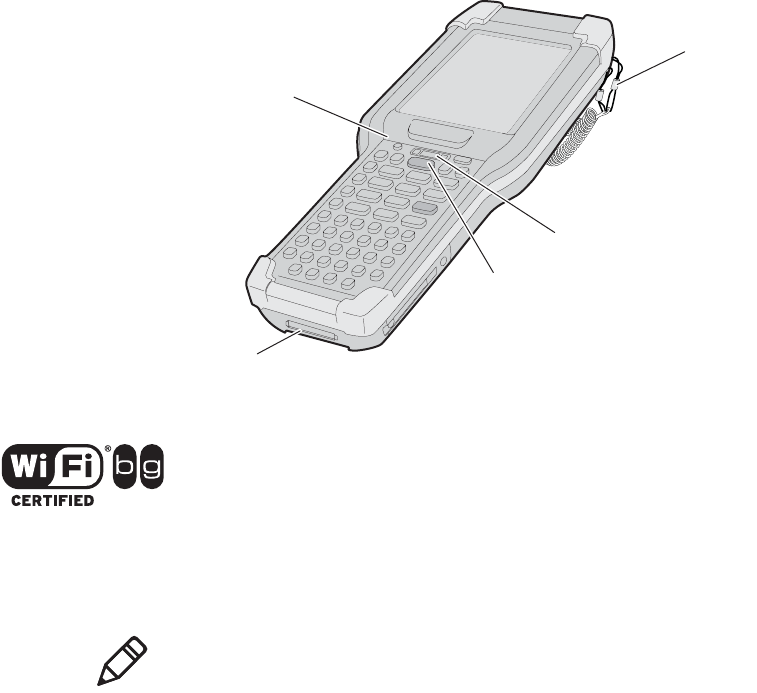
Chapter 1 — Using the Computer
2 CK3 Mobile Computer User’s Manual
Introducing the CK3 Mobile Computer
The Intermec CK3 Mobile Computer is an ergonomically designed
mobile computer built on the Microsoft® Windows® Mobile 6.1
operating system. The CK3 is lightweight, easy-to-use, and runs most
software developed for the Windows Mobile platform, including
standalone, client-server, and browser-based applications.
CK3 Mobile Computer
The CK3 is available with the following features:
•802.11 b/g and Bluetooth® radio, standard
Power button
Docking connector
Scan button
Tethered stylus
Status LEDs
The CK3 Mobile Computer with an IEEE 802.11b/g radio installed
is Wi-Fi® certified for interoperability with other 802.11b/g
wireless LAN devices.
Note: The radio also supports the 802.11d standard. The 802.11d
standard adds the requirements and definitions for 802.11 WLAN
equipment to operate in markets not served by the current
standard. For 802.11d support, you need to order the 802.11d
version of the CK3. For help, contact your local Intermec
representative.

Chapter 1 — Using the Computer
CK3 Mobile Computer User’s Manual 3
•128 MB DRAM, 64 MB Flash
•512 MB embedded SD Mass Storage Card
•Alphanumeric or numeric keypad
•Imaging options:
•EV12 linear imager
•EA20X extended range area imager
•EX25 near-far range area imager
•Intermec Client Pack (Optional):
•Intermec Terminal Emulator, including 3270, 5250, and
VT/ANSI, and support for third-party TE applications
•Intermec Browser
Use this manual to understand how to use the features and options
available on the CK3. For information about Windows Mobile 6.1
applications installed on the CK3, refer to the online help.
Using the Battery
The CK3 uses an AB17 standard or AB18 extended battery as its main
power source. The standard battery has an 7.4 Watt hour capacity, and
the extended battery has a 18.8 Watt hour capacity. Several factors
determine the life of your battery, such as extreme temperatures,
input devices, and your usage.
You must fully charge the battery before you can use the CK3. When
you change the battery, an internal super capacitor maintains your
status, memory, and real-time clock for approximately 10 minutes.
The battery used in this device may present a fire or chemical
burn hazard if it is mistreated. Do not disassemble it, heat it
above 100°C (212°F) or incinerate it. Dispose of used batteries
promptly. Keep away from children.
If you fail to replace the low battery immediately, you may lose
important data or applications.

Chapter 1 — Using the Computer
4 CK3 Mobile Computer User’s Manual
For replacement batteries, contact your Intermec representative.
Charging the Battery
Make sure you fully charge the AB17 or AB18 battery before you use
your CK3. You can charge the battery before or after you install it in
the CK3. A fully discharged battery charges in approximately 4 (AB17)
to 7 (AB18) hours.
To charge the battery
•Insert the battery into the battery bay of the AD20 single dock, or
insert up to four batteries into the AC20 quad battery charger.
Or,
•Install the battery in the CK3 and insert the CK3 into the AD20
single dock, AD21 ethernet multidock, AD22 charge-only
multidock, or AV10 vehicle dock.
Use the next table to understand how long it takes to charge your
batteries in each of the CK3 charger or dock accessories.
Removing and Installing the Battery
To maximize the time allowed to replace the main battery pack, put
the CK3 in suspend mode before removing the battery pack.
Note: If the CK3 is not using external power and you remove the
battery pack, the CK3 goes into Suspend mode.
Charging Times for CK3 Batteries
CK3 Charging Accessory AB17 Charging Time AB18 Charging Time
AC20 quad battery charger up to 4 hours up to 6 hours
AD20 single dock up to 4 hours up to 6 to 7 hours
AD21 ethernet multidock up to 4 hours up to 7 hours
AD22 charge-only multidock up to 4 hours up to 7 hours
AV10 vehicle dock up to 4 hours up to 7 hours

Chapter 1 — Using the Computer
CK3 Mobile Computer User’s Manual 5
To remove and install the battery
1Press and hold for about 2 seconds. When you release , the
CK3 goes into suspend mode.
2If necessary, disconnect the handstrap from the bottom of the
CK3.
3Press the battery release tab toward the battery until the battery
releases, and then lift it away from the CK3.
4Insert the battery into the CK3, and press down on the battery
until it clicks into place.
Maximizing Battery Life
Batteries are chemical devices. If the batteries are left sitting on a shelf
for long periods of time outside the CK3, the batteries slowly
discharge, eventually to zero if left uncharged. The battery chemistry
resists normal degradation if you store the battery in a charger as
opposed to leaving the battery in a discharged state. See the following
table for tips to maximize the life of your battery.
Battery Conservation Tips
When You Want To: Do This to Save Battery Power:
Operate the CK3 and the
Low Battery status icon
appears or the Battery light
comes on.
Press to turn off the CK3. Remove the
battery and insert another fully charged
battery within 10 minutes or you may lose
data. Or, you can connect the CK3 to an
external power source.
Stop using the CK3 for 5
minutes or longer.
Make sure the low battery icon is not on the
screen and that the Battery light is not turned
on. Press to turn off the CK3.
Store the CK3 for more
than a day.
If you are storing the CK3 for a few days, like
over the weekend, install the charged battery
or attach the CK3 to a power source.
If you are storing the CK3 for longer, remove
and charge the battery, then store both the
battery and the CK3 in a cool location.
If the battery in storage is not used in several
months, you should recharge the battery to
keep it at its performance peak.
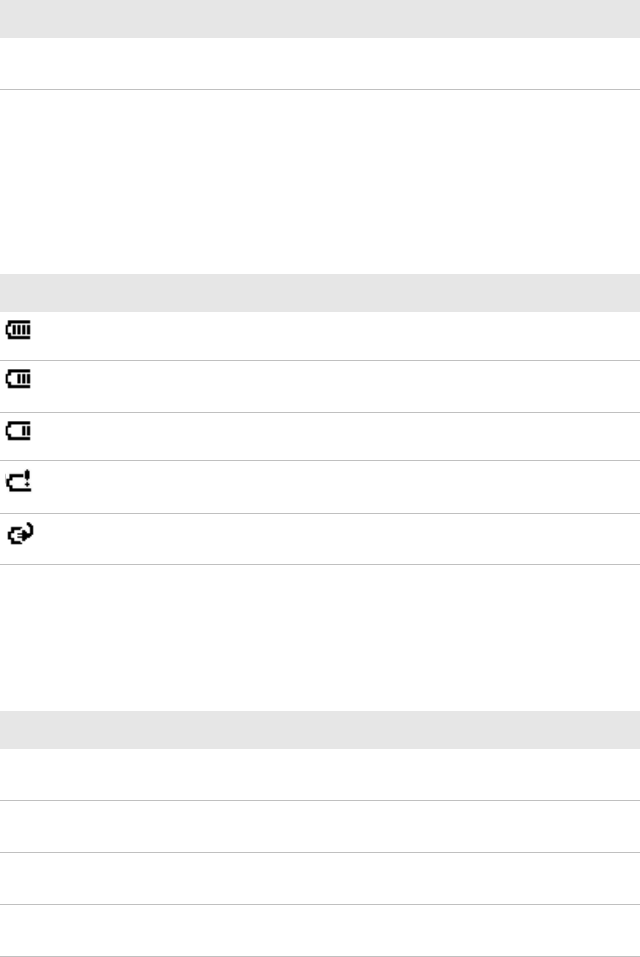
Chapter 1 — Using the Computer
6 CK3 Mobile Computer User’s Manual
Checking the Battery Status
The easiest way to check the status of your battery is to look at the
battery icon on the status bar of your CK3.
The Battery Status LED below your CK3 display indicates the
charging status of your battery.
Store the battery outside the
CK3.
Store the batteries in a charger.
Battery Conservation Tips (continued)
When You Want To: Do This to Save Battery Power:
Battery Icon Status
Icon Status
Battery is fully charged.
Battery has a medium charge. You should be able to work for several
more hours before changing batteries.
Battery is low. You need to replace the battery soon.
Battery is critically low. You need to replace the battery now.
Battery is charging.
Understanding the Battery Status LED
LED State Description
Steady green when the CK3 is
connected to external power
The battery is more than 95% charged.
Blinking red The battery is low. CK3 goes into Suspend
mode. Charge or replace the battery.
Steady red when the CK3 is
connected to external power
The battery is charging.
Steady red when the CK3 is not
connected to external power
The software is not working properly.
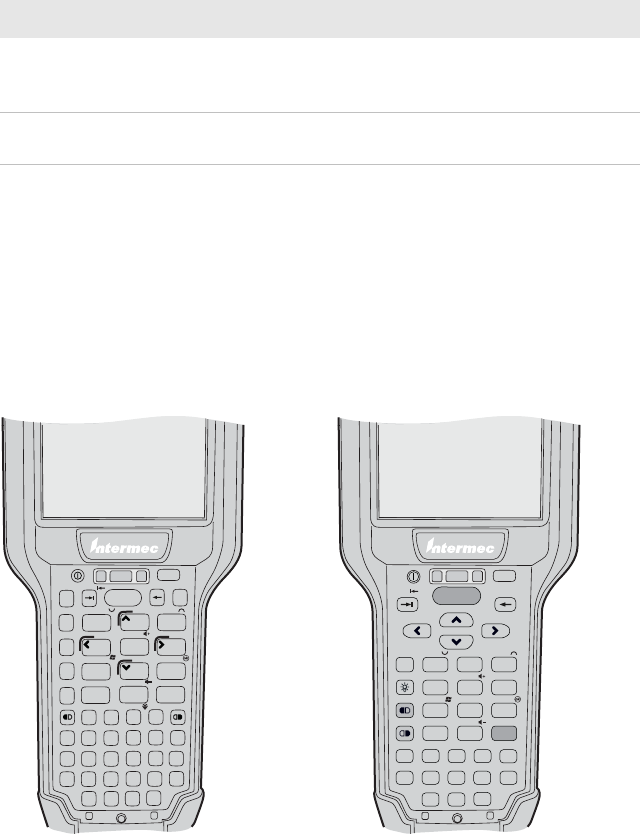
Chapter 1 — Using the Computer
CK3 Mobile Computer User’s Manual 7
Using the Keypad
Use the following sections to understand how to use the keypad. For
information on remapping the keypad, you can download the Device
IDL Resource Kit from the Intermec web site at www.intermec.com/
idl.
The CK3 comes with an alphanumeric keypad or a numeric keypad.
CK3 Alphanumeric Keypad CK3 Numeric Keypad
The full alphabetic keypad is designed for applications that require
primary input of alphabetic data. This keypad also provides special
characters, numbers, symbols, and functions by pressing color-coded
key sequences.
Steady amber The battery is missing or is unable to
charge because the temperature is outside
of the charging range.
Off The CK3 is not on external power and the
battery is operating normally.
Understanding the Battery Status LED (continued)
LED State Description
Shift
Shift
Caps
Caps
F6
F6
F7
F7
F8
F8
F9
F9
F10
F10
F11
F11
F12
F12
F13
F13
F14
F14
F15
F15
F16
F16
F17
F17
F18
F18
F19
F19
F20
F20
F21
F21
F22
F22
F23
F23
F24
F24
Enter
.
Sp
Sp
PTT
PTT
FldExit
FldExit
7
Esc
Esc
F1
F1
F2
F2
F3
F3
F4
F4
F5
F5
89
456
123
0
ABCD
FGHI
LMNOP
R
E
K
QSTUV
WXYZ
J
N O P Q R
S T U V
X Y Z
W
A
E
D
H
K
B
F
I
L
C
G
J
M
F13
F13
F14
F14
F15
F15
F16
F16
F18
F18
F17
F17
F19
F19
F20
F20
F21
F21
F22
F22
F23
F23
F24
F24
Enter
Enter
Shift
Shift
Caps
Caps
Space
Space
PTT
PTT
7 8 9
4 5 6
1 2 3
0
Esc
.
F2
F2
F3
F3
F4
F4
F5
F5
F7
F7
F11
F11
F12
F12
F9
F9
F8
F8
F10
F10
F6
F6
F1
F1
FldExit
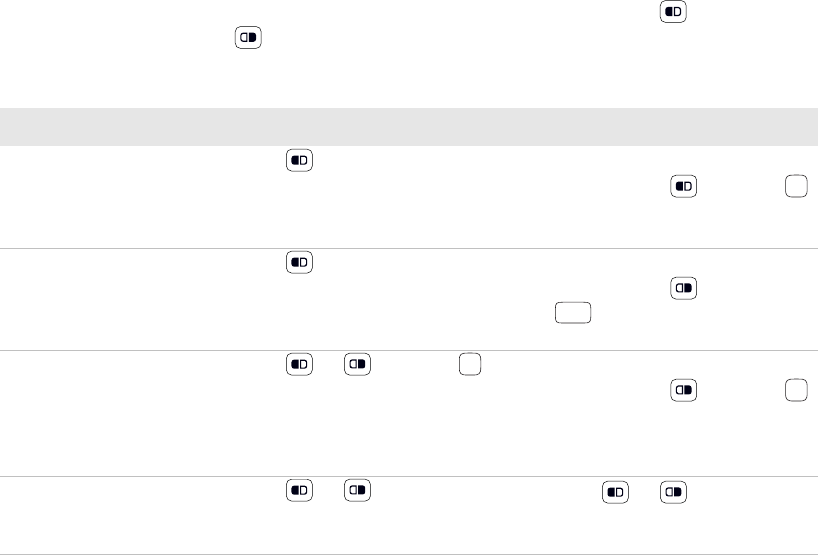
Chapter 1 — Using the Computer
8 CK3 Mobile Computer User’s Manual
The numeric keypad is for applications that require mainly numeric
data. This keypad also lets you enter special characters, including the
alphabet, by pressing color-coded key sequences.
Using the Color-Coded Keys
Each keypad provides color-coded keys to let you access additional
characters, symbols, and functions printed on the keypad overlay.
Once you understand how to use the color-coded keys and key
sequences, you can access all of the additional features printed on the
keypad overlay.
There are two color-coded modifier keys: the orange key and the
green key.
Using the Color-Coded Keys
You Want to: Press: Example
Use an orange character or
function printed above a key.
key (LED turns on) and
then the key with the character
or function printed above it
(LED turns off).
On the CK3 alphanumeric
keypad, press and then
to select the F18 function.
Use a green character or
function printed above a key.
key (LED turns on) and
then the key with the character
or function printed above it
(LED turns off).
On the CK3 alphanumeric
keypad, press and then
to select the ok function.
Lock the orange or green key to
stay on.
or and then to
select the Shift function.
On the CK3 alphanumeric
keypad, press and then
to select the Shift function.
The green LED turns on and
stays on.
Unlock the green or orange key. or once. Press or once to
unlock the key. The LED turns
off.
Q
3
A
A

Chapter 1 — Using the Computer
CK3 Mobile Computer User’s Manual 9
Capitalizing Characters
You can capitalize characters individually, or you can type all capital
letters by enabling Caps Lock.
To capitalize a single character
•On the alphanumeric keypad, press the key, and then the
key to select the Shift function. Press the key, and the
character.
•On the numeric keypad, press the key, and then the key to
select the Shift function.
To enable Caps Lock
•On the alphanumeric keypad, press , then the key. Press
again to disable the Caps Lock.
•On the numeric keypad, press .
The Caps Lock LED lights up green to show that the CK3 is in the
Caps Lock mode.
To disable Caps Lock
•Press the color modifier key again.
For information on how to enter specific characters with keystrokes,
see Appendix C, “Keypads and Keystrokes” on page 105.
Using the Power Button
When you press the Power button ( ), you put the CK3 into suspend
mode. In this lower power mode, the CK3 continues to supply power
to all memory, but turns off power to most hardware such as the
display. This power-saving feature is designed to prolong battery life.
Configuring the Backlight Settings
By default, the CK3 goes into Screen Off mode when there is no
activity on the computer. Screen Off mode turns off the backlight and
display. Press a key or tap the screen to resume activity.
A
B
1

Chapter 1 — Using the Computer
10 CK3 Mobile Computer User’s Manual
To configure the backlight
1Tap Start > Settings > the System tab > the Backlight icon > the
Battery Power tab.
2With Turn off backlight if device is not used for checked, select
the timeout value (10 seconds, 30 seconds, or 1 to 5 minutes).
You can also use Intermec Settings to configure the backlight
settings.
Understanding the Audio Features
The CK3 has a speaker, a microphone, and multiple software tools for
configuring the volume of sounds.
Adjusting the Volume of the Speaker
You can adjust the computer volume for your needs and your
environment. The volume includes sounds you hear when you tap the
screen or scan bar codes with a scanner. You can set the volume to off,
very low, low, medium, high, and very high (default).
To adjust the volume of the speaker with the Volume icon
1Tap the Volume ( ) icon at the top of the screen.
2Use your stylus to adjust the volume slider.
You can also use Intermec Settings to adjust the volume.
Using the Push To Talk (PTT) Feature
You can use the PTT feature to:
•record audio on your CK3.
•use your CK3 as a two-way radio.
Chapter 1 — Using the Computer
CK3 Mobile Computer User’s Manual 11
Recording Audio on Your CK3
You can use the PTT key in the upper right corner of the keypad to
automatically record audio on your CK3. What happens when you
press the PTT key depends on whether your CK3 is on or in suspend
mode:
•If your CK3 is on:
•Press the PTT key to start the Note application in audio note
mode.
•Press and hold the PTT key to start the Note application in
audio note mode and start recording. You can record using the
internal microphone or a headset microphone attached to the
CK3 through the AA20 audio adapter. To stop recording,
release the PTT button.
•If your CK3 is in suspend mode:
•Press the PTT key to turn on CK3.
•Press and hold the PTT key for about 2 seconds to turn on the
CK3 and start the Note application in audio note mode.
•Press and hold the PTT key for more than 2 seconds to turn on
the CK3, start the Note application in audio note mode, and
start recording. You can record using the internal microphone
or a headset microphone attached to the CK3 through the
AA20 audio adapter. To stop recording, release the PTT key.
To order the AA20 audio adapter, contact your local Intermec
representative.
Using Your CK3 as a Two-Way Radio
You can also use the PTT feature with audio applications, such as
iTalkie™ or 4Talk to communicate between two or more CK3s over
the 802.11b/g radio network. You press the PTT button to talk to
another CK3.
For more information, go to www.tabletmedia.com/iTalkie.html or
www.4pockets.com.
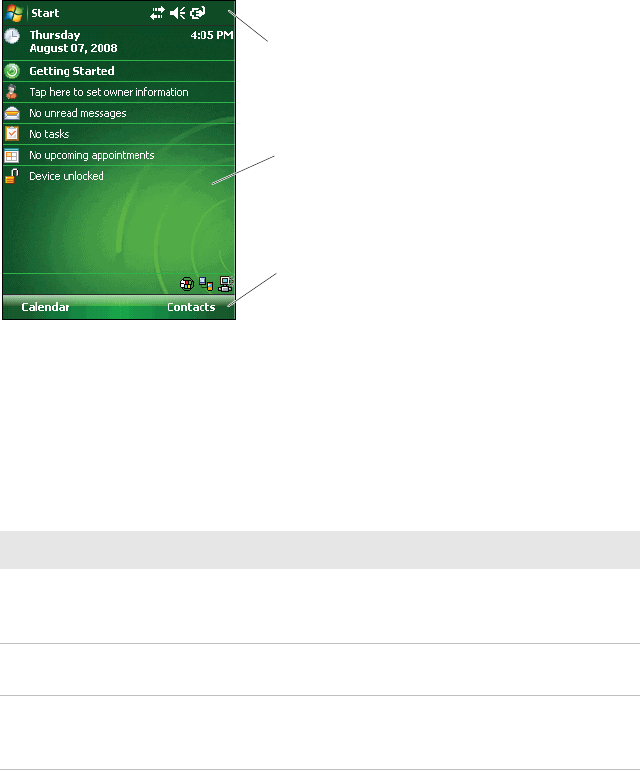
Chapter 1 — Using the Computer
12 CK3 Mobile Computer User’s Manual
Using the Touch Screen
The CK3 has a 240 x 320 pixel color touch screen display. The
Windows Mobile 6.1 start screen has three distinct areas: the
navigation bar, today screen, and command bar.
Windows Mobile 6.1 Start Screen
Using the Stylus
Your computer has a stylus for selecting items and entering
information on the touch screen.
Navigation bar
Today screen
Command bar
Functions You Can Perform With the Stylus
Action Description
Tap Touch the screen once with the stylus to select options,
open or close applications, or launch menus from the
Command bar.
Drag Hold the stylus on the screen and drag across the screen to
select text and images.
Tap and hold Tap and hold the stylus on an item to see a menu of
actions available for that item. On the pop-up menu that
appears, tap the action you want to perform.
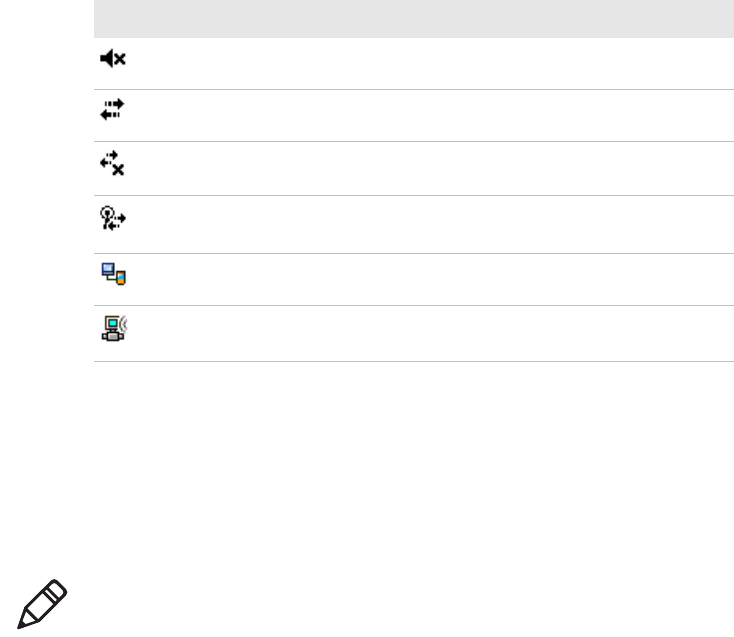
Chapter 1 — Using the Computer
CK3 Mobile Computer User’s Manual 13
Understanding the Screen Icons
Use the screen icons on the navigation bar and the command bar to
see the network connection status and other system information. For
information about the battery icons, see “Checking the Battery
Status” on page 6. Some standard Microsoft icons are included in
this table.
Aligning the Touch Screen
If the touch screen does not respond when you tap it with the stylus,
you may need to calibrate the screen.
To calibrate the touch screen
1Tap Start > Settings > the Systems tab > Screen.
2Tap Align Screen and follow the instructions to align the screen.
3Click ok.
Screen Icons
Icon Description
The volume is turned off. To turn the volume back on, tap this icon
and choose your setting.
The computer is connected to the network.
The computer is not connected to the network.
The 802.11b/g radio is connected to the wireless network.
The computer is connected through the USB port to your desktop
PC.
The iConnect application icon. Tap it to set up Ethernet or Wireless
settings.
Note: If the touch screen is so out of alignment that you cannot
open the Start menu, you can try to align the screen menu using
the keypad. For help, see the next procedure.
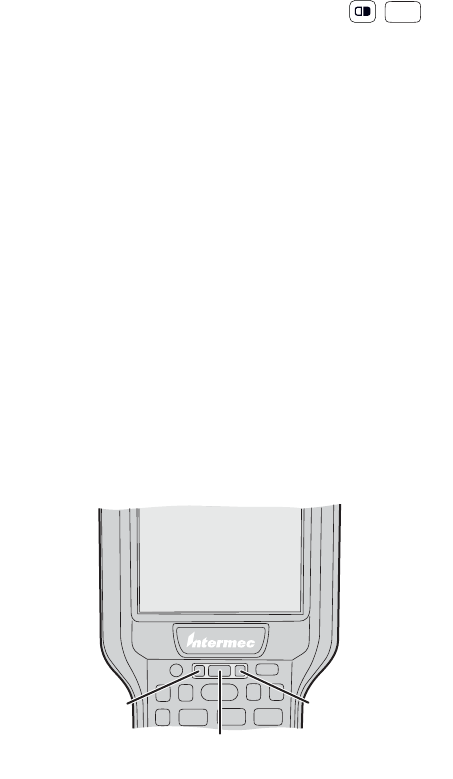
Chapter 1 — Using the Computer
14 CK3 Mobile Computer User’s Manual
To align the touch screen using the keypad
1Access the Start menu by pressing .
2Press the Down button to select Settings.
3Press Enter.
4Press the Tab button until the Settings tabs are highlighted.
5Press the Right Arrow button to select the System tab.
6Press Tab until the Screen icon is highlighted.
7Tab to Align Screen and press Enter.
8Follow the instructions to align the screen.
9Click ok.
If you are still unable to align the touch screen, you can clean boot the
CK3. For help, see “Clean Booting the CK3” on page 74.
Understanding the Status LEDs
The CK3 has three status LEDs.
Status LEDs
1
Notification LED Battery status LED
Good read LED and Intermec
Ready-to-Work indicator

Chapter 1 — Using the Computer
CK3 Mobile Computer User’s Manual 15
The next table describes the notification LED, good read LED, and
Intermec Ready-to-Work™ indicator. For information about the
battery status LED, see “Understanding the Battery Status LED”
on page 6.
The Intermec Ready-to-Work indicator (blue light) is used by
Intermec’s SmartSystems Foundation, an application that lets you
manage all of your SmartSystems-enabled devices simultaneously
from a central location. For more information, see “Configuring the
CK3 Remotely With SmartSystems Foundation” on page 28, or
contact your Intermec representative. Custom applications may also
use the blue light for other purposes.
Understanding the Status LEDs
LED Color Description
Notification Orange The CK3 is notifying you of a pending
alarm or message.
Good Read Green The CK3 has successfully decoded a bar
code.
Intermec Ready-to-
Work indicator
Blue The CK3 is suspending or resuming
with the display turned off.
Blinking blue You have successfully loaded and
activated Intermec Terminal Emulator.
The Intermec Terminal Emulator
application is loaded, but is inactive.
Off The Intermec Terminal Emulator
application is missing or disabled.
Caution: The blue light usually turns off within 10 seconds, but it
may stay on for up to 30 seconds. During this time, do not press
or remove the battery, or you may corrupt the data on your
CK3.
Chapter 1 — Using the Computer
16 CK3 Mobile Computer User’s Manual
Scanning Bar Codes
The CK3 ships with an internal imager to scan and enter bar code
data. You can also connect to:
•cordless scanners, such as the SF51 and SR61 through Bluetooth
communications. For help, see “Connecting to a Bluetooth
Scanner” on page 31.
•tethered scanners, such as the SR30 and SR61T through the
CK3 RS-232 adapter (Model AA21). For help, see the CK3 RS-232
Adapter (AA21) Instructions (P/N 943-182-xxx).
The type of imager you are using and the type of bar code you are
decoding determines the way you scan the bar code. Depending on
the imager model in your CK3, the CK3 supports reading 1D linear
bar codes, 2D images, and composite and postal codes.
By default, these bar code symbologies are enabled on the CK3:
•Code 39
•Code 128/GS1-128
•DataMatrix (area imagers only)
•PDF417 (if supported)
•EAN/UPC
If you are using bar code labels that are encoded in a different
symbology, you need to enable the symbology on the CK3. Use
Intermec Settings to enable and disable symbologies. For help, see
“Configuring the CK3 With Intermec Settings” on page 27.
The next two sections describe how to scan a bar code label with the
linear imager, area imager, and near-far range area imager.
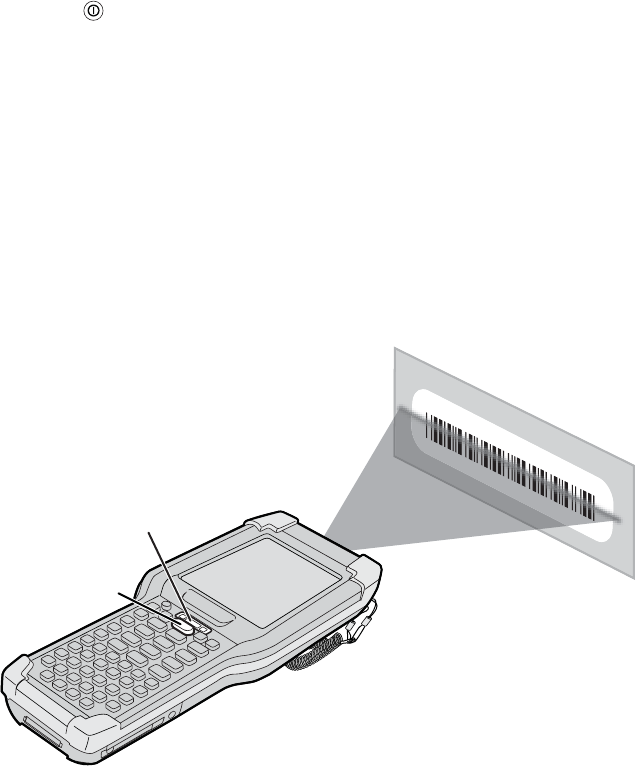
Chapter 1 — Using the Computer
CK3 Mobile Computer User’s Manual 17
Scanning With the Linear Imager
If your CK3 has a linear imager, use the following procedure to
practice scanning a bar code.
To scan bar code labels with the linear imager
1Press to turn on the CK3.
2Point the scanner window at the bar code label and hold the CK3
at a slight angle 15 to 25 cm (6 to 10 in) from the label.
3Press the Scan button on the keypad, or pull the trigger on a
handle, and direct the red beam so that it falls across all bars in the
bar code label.
Use this test bar code:
Code 39 Test Bar Code
*123456*
*123456*
When the CK3 successfully reads a bar code label, you hear a high
beep and the green Good Read light turns on briefly.
4Release the Scan button or trigger.
Good read LED
Scan button
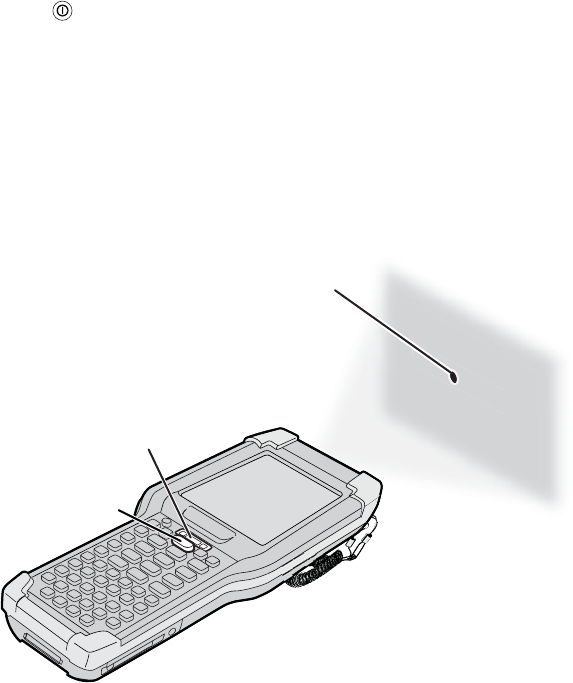
Chapter 1 — Using the Computer
18 CK3 Mobile Computer User’s Manual
Scanning With an Area Imager
Your CK3 may come with one of two types of area imagers:
•Extended range area imager
•Near-far range area imager
Both area imagers are equipped with a laser pointer to help you aim at
bar codes, allow you to scan 2D bar code symbologies, and support
omni-directional (360°) scanning. Omnidirectional scanning lets you
position the CK3 in any orientation to scan a bar code label.
Scanning With the Extended Range Area Imager
1Press to turn on the CK3.
2Point the scanner window at the bar code label, and hold the CK3
steady a few inches from the label.
3Press the Scan button or pull the trigger. The laser pointer and
illumination beam and frame appear.
4Use the laser pointer as a guide and aim toward the middle of the
bar code. Make sure that the illumination frame covers the bar
code you are trying to decode.
Good read LED
Scan button
*JOHNB*
*JOHNB
*
Laser pointer

Chapter 1 — Using the Computer
CK3 Mobile Computer User’s Manual 19
When the CK3 successfully reads a bar code label, you hear a high
beep, and the Good Read LED turns on briefly.
5Release the Scan button or trigger.
Scanning With the Near-Far Range Area Imager
1Press to turn on the CK3.
2Point the scanner window at the bar code label.
3Press the Scan button or pull the trigger. The illumination beam
and laser pointer appear.
•For near or close-in scanning distances of 30 cm (11.8 in) or
less, use the laser pointer as a guide and aim slightly to the
right of the center of the bar code. Make sure the illumination
beam covers the bar code you are trying to decode.
•For standard and long range scanning distances of 30 cm
(11.8 in) or more, use the laser pointer as a guide and aim
toward the middle of the bar code. Make sure that the
illumination beam covers the bar code you are trying to
decode.
When the CK3 successfully reads a bar code label, you hear a high
beep, and the Good Read LED turns on briefly.
4Release the Scan button or trigger.
Improving the Performance of the Area Imager
If you experience problems scanning a bar code with the 2D imager,
try these possible solutions.
•Keep your hand as steady as possible while scanning a label.
•Position the imager as close to the bar code as possible while still
being able to capture the entire bar code.
•Enable only the bar codes that you need to use every day.

Chapter 1 — Using the Computer
20 CK3 Mobile Computer User’s Manual
•Choose a Predefined mode in Intermec Settings:
aTap Start > Settings > the System tab > Intermec Settings.
bTap Data Collection > Internal Scanner > Imager Settings >
Predefined Modes and then select one of these options:
•If you are scanning multiple bar codes in a small area, use one of
these parameters:
•Aiming beam activation
•Aim triggering mode
•Center decoding
To enable these parameters, use Intermec Settings. For help, see
“Configuring the CK3 With Intermec Settings” on page 27.
For help scanning using center decoding, see the next procedure.
To scan a bar code using center-decoding
1Press to turn on the CK3.
2Point the scanner window at the bar code label.
3Press the Scan button or pull the trigger. The illumination beam
and the laser pointer appear.
Predefined Mode Select if You Are Scanning:
1D Only 1D labels.
1D and 2D
Standard
All types of bar code labels.
1D and 2D Bright
Environment
In high ambient light, such as outdoors in the
sunshine.
1D and 2D
Reflective Surface
Glossy labels.
Custom In conditions that require customized settings.
For more information about these settings,
commands, and parameters, see the Intermec
Settings Command Reference Manual available from
the Intermec web site at www.intermec.com.
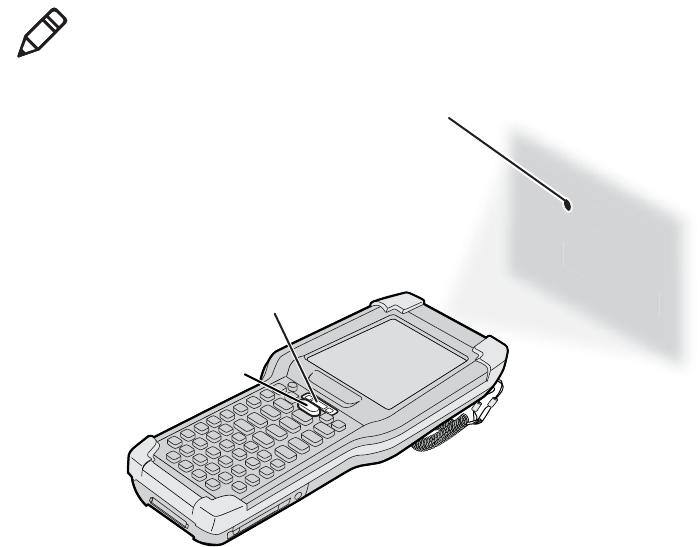
Chapter 1 — Using the Computer
CK3 Mobile Computer User’s Manual 21
4Aim both the illumination beam and the laser pointer at the bar
code you want to scan.
When the CK3 successfully reads a bar code label, you hear a high
beep and the green Good Read light turns on briefly.
Using a microSD Card
You can use a micro Secure Digital (SD) card to increase file storage
and install software. Your CK3 supports microSD cards that hold up
to 2 GB of information. The microSD card slot is located in the
battery compartment.
To install a microSD card
1Remove the battery. For help, see “Removing and Installing the
Battery” on page 4.
Note: The center-decoding parameter only decodes a bar code if
the laser pointer is on the bar code and the illumination beam
covers the bar code.
*JOHNB*
*JOHNB*
*JOHNB
*
*JOHNB
*
Laser pointer
Good read LED
Scan button
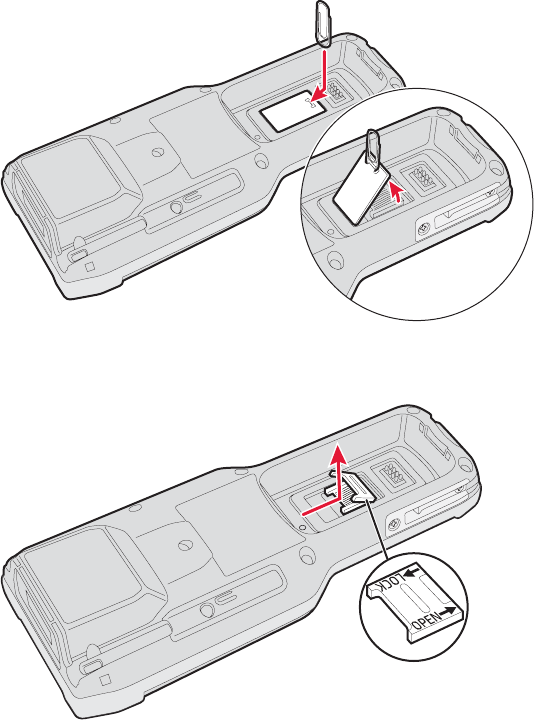
Chapter 1 — Using the Computer
22 CK3 Mobile Computer User’s Manual
2Use a paper clip or slotted screwdriver to remove the cover.
3Slide the microSD card cover toward the OPEN position and lift
the cover.
4Insert the microSD card.
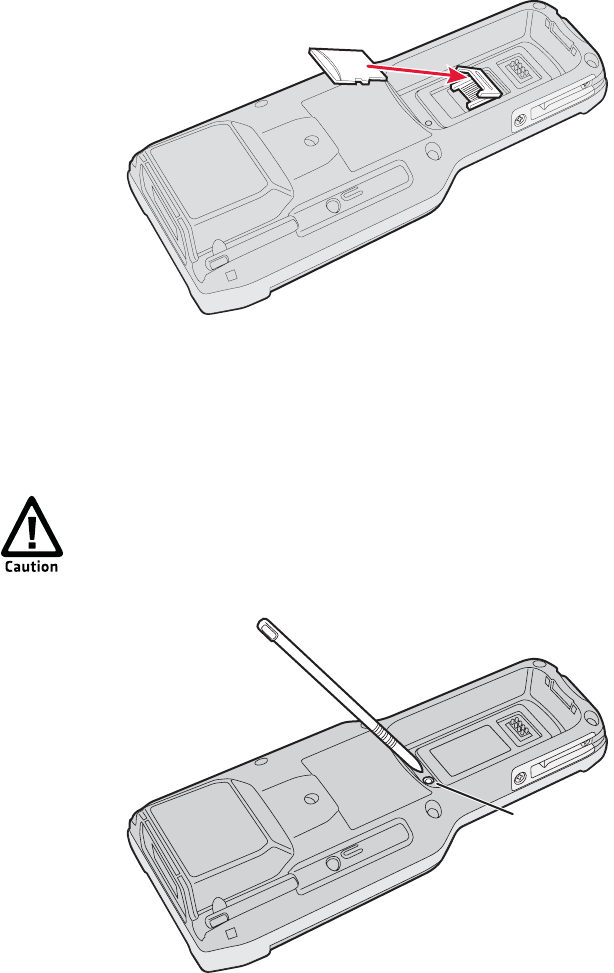
Chapter 1 — Using the Computer
CK3 Mobile Computer User’s Manual 23
5Close the microSD card cover, and slide the cover toward the
LOCK position.
6Replace the cover.
7Use the stylus to press the reset button in the battery
compartment of the CK3.
8Install the battery.
Do not use force or a sharp object when pressing the reset
button. You may damage the reset button.
Reset button

Chapter 1 — Using the Computer
24 CK3 Mobile Computer User’s Manual
9Press to turn on the CK3:
•You should be able to navigate to the SDMMC Disk folder and
see the contents of the microSD card.
•If the microSD card is bootable, your CK3 boots from the card.
•If the microSD card contains operating system upgrade
files, the upgrade process automatically starts. For more
information, see “Upgrading the System Software” on
page 61.
For troubleshooting information, see “Troubleshooting Your CK3”
on page 67.

25
2Connecting and Configuring the
CK3
Use this chapter to understand how to configure the CK3 to
communicate in your network. This chapter contains these
topics:
•Connecting to a PC
•Configuring the CK3 Parameters
•Configuring the CK3 for Your Network
•Configuring Wireless Security
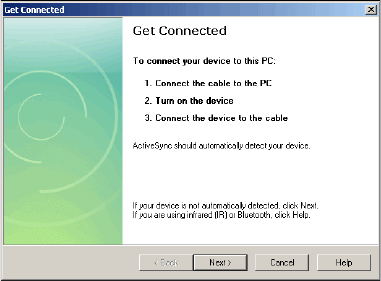
Chapter 2 — Connecting and Configuring the CK3
26 CK3 Mobile Computer User’s Manual
Connecting to a PC
You can use Microsoft ActiveSync to establish a connection between
your CK3 and PC. ActiveSync lets you transfer files, synchronize files,
remotely debug, and perform other device management activities.
ActiveSync is a free application available from the Microsoft web site.
To establish an ActiveSync partnership between your CK3 and PC,
you need to physically connect your CK3 to your PC using these
accessories:
•AD20 single dock
•USB to mini-USB cable
To establish an ActiveSync partnership
1Download ActiveSync from the Microsoft web site and install
ActiveSync on your PC. When installation is complete, the Get
Connected dialog box appears.
2Follow the onscreen instructions to establish a partnership.
When the partnership is established, the Microsoft ActiveSync
screen appears on your PC.

Chapter 2 — Connecting and Configuring the CK3
CK3 Mobile Computer User’s Manual 27
Configuring the CK3 Parameters
You can configure many parameters on the CK3, such as the bar code
symbologies it decodes or the network settings. These characteristics
are controlled by configuration parameters. The values you set for
these configuration parameters determine how the CK3 operates.
Configuring the CK3 With Intermec Settings
Use Intermec Settings to configure the CK3 and view system
information.
To open Intermec Settings
•Tap Start > Settings > the System tab > Intermec Settings.

Chapter 2 — Connecting and Configuring the CK3
28 CK3 Mobile Computer User’s Manual
For information about each command, see the Intermec Settings
Command Reference Manual (P/N 937-016-xxx).
Configuring the CK3 Remotely With SmartSystems
Foundation
Intermec’s SmartSystems Foundation lets you manage all of your
SmartSystems-enabled devices simultaneously from a central
location. The SmartSystems console displays all of the SmartSystems-
enabled devices in your network.
Your CK3 is SmartSystems-enabled, which lets you open Intermec
Settings from the SmartSystems console to remotely configure all of
your CK3 computers.
To open Intermec Settings from the SmartSystems console
1In the SmartSystems console, right-click a CK3.
2Select Intermec Settings.
For more information about SmartSystems Foundation, go to the
Intermec web site at www.intermec.com/SmartSystems.
Configuring the CK3 for Your Network
The CK3 is a versatile mobile computer that you can easily add to
your wireless or wired data collection network. You can connect your
CK3 using:
•802.11b/g radio communications.
•Bluetooth communications.
Navigating in Intermec Settings
To Perform
This Action Do This
Select a command. Tap the command or use the up and down arrow keys.
Expand a command. Tap the command or use the left and right arrow keys.
Select text in a text
box.
Tap in the text box and drag the stylus over the text.
Save your settings. Tap File > Save Settings or tap .

Chapter 2 — Connecting and Configuring the CK3
CK3 Mobile Computer User’s Manual 29
•Ethernet communications
•USB and serial communications.
Configuring 802.11b/g Radio Communications
Your CK3 has an 802.11b/g radio to transfer data using wireless
communications. This section assumes that your wireless network is
set up, including your access points.
To configure 802.11b/g radio parameters
1Tap Start > Settings > the Systems tab >Intermec Settings.
2Tap Communications > 802.11 Radio > Funk Security >
[Profile #] > SSID.
3Enter your SSID (network name).
4If you are not using DHCP, tap IP Settings and configure your
network settings.
5Make sure that your CK3 is talking to the network and that the
network can see your CK3.
6Configure security. For help, see “Configuring Wireless
Security” on page 37.
Configuring Bluetooth Communications
You CK3 is Bluetooth™-enabled, which lets you connect to other
Bluetooth devices, such as:
•scanners.
•printers.
•audio devices.
You need to turn on the Bluetooth radio before you can discover and
connect to other Bluetooth devices. By default, the radio is turned off.
Make sure all components with antennas are at least 30 cm (1 ft)
apart when power is applied. Failure to comply could result in
equipment damage.
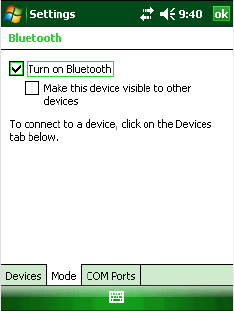
Chapter 2 — Connecting and Configuring the CK3
30 CK3 Mobile Computer User’s Manual
To turn on the Bluetooth radio
1Tap Start > Settings > the Connections tab > Bluetooth > the
Mode tab.
2Tap Turn on Bluetooth.
3(Optional) If you want your CK3 to be visible to other Bluetooth
devices, tap Make this device visible to other devices.
4Click ok.
The Bluetooth radio maintains its current state through a warm or
cold boot and maintains virtual COM ports. But, if you clean boot
your CK3, you need to recreate pairings to devices.
You can also access Bluetooth settings using Intermec Settings.
To access Bluetooth settings using Intermec Settings
•In Intermec Settings, tap Communications > Bluetooth.
For more information about Bluetooth settings, see the Intermec
Settings Command Reference Manual (P/N 937-016-xxx).
Chapter 3 — Developing and Installing Applications
CK3 Mobile Computer User’s Manual 61
Upgrading the System Software
When you upgrade your computer, you are updating the operating
system (OS) and the SmartSystems Platform Bundle (SSPB) files.
The SSPB files are stored on the DiskOnChip and deliver Intermec
Value Add (IVA) functionality such as data collection, configuration,
the Intermec wireless security suite, and SmartSystems Foundation.
As new features are added to these components, you can upgrade your
SSPB files without needing to upgrade the operating system.
Alternately, you can choose to upgrade only the operating system if
you need new functionality. If you upgrade the operating system, you
will need to reinstall SSPB files.
There are two ways to upgrade your computer:
•You can upgrade your computer using an storage card. For help,
see the next section, “Upgrading the CK3 Using a microSD
Card.”
•You can upgrade your computer using the SmartSystems Console.
For help, see “Upgrading the CK3 Using SmartSystems
Foundation” on page 63.
You need to download the latest upgrade files from the Intermec web
site to your PC.
To download the upgrade files
1Start your web browser and go to the Intermec web site at
www.intermec.com.
2Go to Support > Downloads.
3Click the link to search the product downloads.
4Select your computer from the Downloads list. The Downloads
page displays all of the downloads available for your computer.
5Download the upgrade file you need. If you want to upgrade both
the OS and the SSPB, you will need to download both files.

Chapter 3 — Developing and Installing Applications
62 CK3 Mobile Computer User’s Manual
Upgrading the CK3 Using a microSD Card
To use a microSD card to upgrade the computer, you need an SD card
reader and a microSD adapter card formatted as FAT16.
To upgrade the operating system using a microSD card
1Insert a microSD card into a microSD adapter card and then place
it in the storage card reader connected to your PC.
2Copy all required OS upgrade files to the microSD card.
3Remove the microSD card from the adapter card and insert it into
the CK3.
4Place the CK3 in a dock connected to external power and press the
Reset button (using a stylus) located in the battery cavity on the
back of the CK3. For help, see “Cold Booting the CK3” on
page 73.
5Remove the microSD card when the Installation Complete menu
appears.
6Remove the CK3 from the dock and replace the battery.
To upgrade the SSPB using a microSD card
1Insert a microSD card into a microSD adapter card and then place
it in the storage card reader connected to your PC.
2Copy all required SSPB upgrade files to the microSD card.
3Remove the microSD card from the adapter card and insert it into
the CK3.
4Using the stylus, press the Reset button in the battery
compartment.
5Press and hold as you insert the battery back into the CK3.
6Continue to hold until a Warning message appears.
7Release , read the message, and press either button on the right
side to continue.
8Perform the screen alignment and wait for the CK3 to load files
from the microSD card.
When the progress is complete, the CK3 warm boots to reset the
configuration.

Chapter 3 — Developing and Installing Applications
CK3 Mobile Computer User’s Manual 63
9Remove the microSD card and delete the files.
10 Set the date, time, and network communication parameters to
reestablish communications with the other devices in the wireless
network.
Upgrading the CK3 Using SmartSystems Foundation
You can use the SmartSystems console to upgrade the operating
system on your CK3. The console is part of SmartSystems Foundation
and is available from the Intermec web site through the Intermec
Developer Library (IDL). Before you can upgrade your CK3, you need:
•SmartSystems Foundation. To download SmartSystems
Foundation, go to www.intermec.com/idl and open the Device
Management page.
•the device upgrade .exe file. This file is available from the Intermec
web site at www.intermec.com. Go to Support > Downloads.
Make sure the file you select is for your language.
To upgrade the computer using SmartSystems Foundation
1Install SmartSystems Foundation on your PC and open the
SmartSystems console.
2Make sure the SmartSystems console and CK3 are on the same
subnet.
3Make sure your CK3 is either in a communications dock or
charging dock or that power management is disabled.
4Download the device upgrade .exe file to your PC.
5Double-click the .exe file on your PC. An InstallShield application
starts and walks you through the process of extracting the
upgrade files to the default location.
6From the SmartSystems console, locate the device upgrade to
install.
Note: Do not change the default location where InstallShield
extracts the files. The SmartSystems console requires the files to
be in this location.

Chapter 3 — Developing and Installing Applications
64 CK3 Mobile Computer User’s Manual
7Drag the application to each CK3 you want to upgrade or to a
group of CK3s in a folder.The SmartSystems console installs the
upgrade on your computers.
After the download is complete, your CK3 replaces the operating
system and automatically performs a cold boot.
Note: The SmartSystems console indicates that your CK3 is offline,
by displaying a red stop sign symbol, until the CK3 reboots and
reconnects to the system.

65
4Troubleshooting and
Maintaining the CK3
This chapter contains possible solutions to problems you
may encounter while using the CK3. This chapter also
contains information on booting the computer and
performing regular maintenance.
Chapter 4 — Troubleshooting and Maintaining the CK3
66 CK3 Mobile Computer User’s Manual
Calling Product Support
To talk to an Intermec Product Support representative, call
1-800-755-5505.
Before you call Intermec Product Support, make sure you have the
following information ready:
•Configuration number
•Operating system version
•SmartSystems Platform Bundle (SSPB) version
•If you are using security, know the type (Funk or Microsoft) and
the full set of parameters
•Power management settings
•If you are using Intermec Terminal Emulation (ITE), know the
version and protocol
•If you are not using ITE, know the language your custom
application was written in and the tools you used to create it
You can find most of the information listed above in Intermec
Settings. Consult your application developer for information on your
custom application.
To find your configuration number
•Look at the CN field of the configuration label on the back of your
CK3.
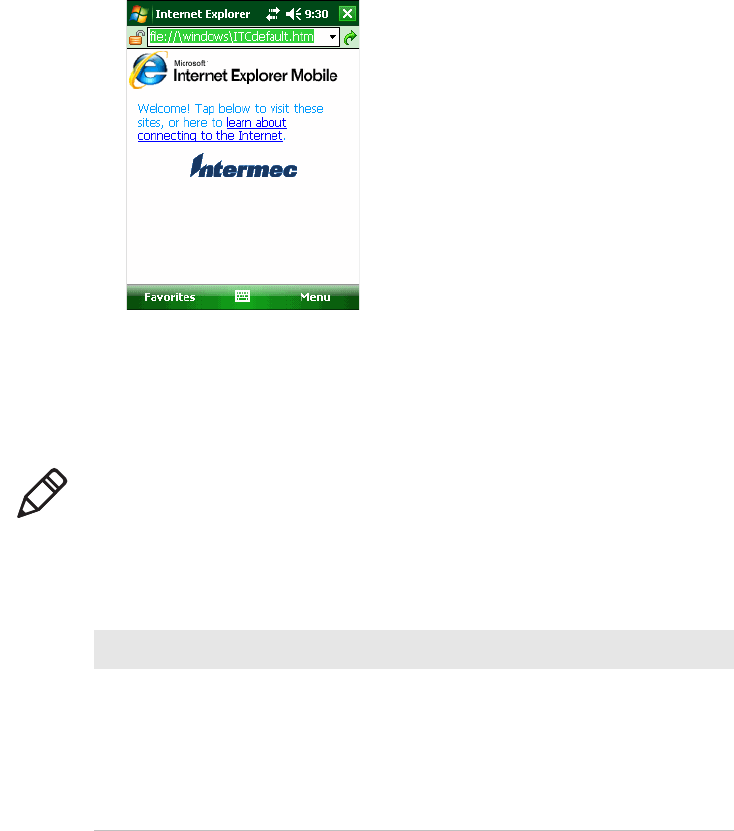
Chapter 4 — Troubleshooting and Maintaining the CK3
CK3 Mobile Computer User’s Manual 67
To find your operating system version
1Tap Start > Internet Explorer.
2Tap the Intermec logo. The Intermec page appears and displays
the version of the operating system and the SmartSystems
Platform Bundle (SSPB) loaded on your CK3.
Troubleshooting Your CK3
Use this section to troubleshoot some common problems you may
experience with your CK3.
Note: If you send the CK3 in for service, it is your responsibility to
save the computer data and configuration. Intermec is responsible
only for ensuring that the hardware matches the original
configuration when repairing or replacing the computer.
Problems While Configuring the CK3
Problem Possible Solution
You scan a
configuration
command, such as
Beeper Volume, and
you hear three low
beeps and nothing
happens.
If you are working in Intermec Settings, you cannot
scan configuration commands. Exit the application
to scan configuration commands.

Chapter 4 — Troubleshooting and Maintaining the CK3
68 CK3 Mobile Computer User’s Manual
You scan or enter
an option for the
Scanner Model
configuration
command, and you
hear three low beeps
and nothing
happens.
You may have scanned or entered a Scanner Model
command that does not apply to the type of scanner
that you have installed. Try scanning or entering the
Scanner Model command again and select an option
for the type of device you are using.
You cannot type a
character on the
keypad or you can
only type uppercase
or lowercase letters.
You may have locked a modifier key on the keypad.
Press the necessary key sequence to unlock the key.
For help, see “Using the Keypad ” on page 7.
You press and
nothing happens.
•Make sure the backlight is on.
•Make sure you have a charged battery that is
installed correctly. For help, see “Charging the
Battery” on page 4.
•The battery may be discharged. Replace the battery
with a spare charged battery, or charge the battery.
•Reset the CK3. For help, see “Resetting the CK3”
on page 73.
You insert a
microSD card and
cannot find the
SDMMC Disk folder
on the CK3. Or, you
insert a bootable SD
card and the CK3
does not boot from
the card.
•The microSD card may not be installed correctly.
Insert the microSD card as described in Steps 2
through 4 of “Using a microSD Card” on
page 21.
•The microSD card may be damaged. Try another
microSD card.
The Battery status
LED is on.
•If the battery status LED is a steady green, the
battery is more than 95% charged and computer is
on a charger.
•If the battery status LED is blinking red, then the
battery is low. Replace or charge the battery.
•If the battery status LED is a steady red, the main
battery is on charge.
Problems While Configuring the CK3 (continued)
Problem Possible Solution

Chapter 4 — Troubleshooting and Maintaining the CK3
CK3 Mobile Computer User’s Manual 69
The computer
appears to be locked
up and you cannot
enter data.
•Press the power key to turn off the CK3, and then
press the power key again to turn it on.
•Press and hold the power key 5 seconds to warm
boot the CK3.
•Try reloading the firmware. For help, see
“Upgrading the System Software” on page 61.
•If the CK3 does not boot or reset, contact your
Intermec representative for help.
You tap the screen
and nothing
happens.
Align your screen. For help, see “Aligning the Touch
Screen” on page 13.
Problems With Wireless Connectivity
Problem Possible Solution
When you turn on
the CK3 after it was
suspended for 10 to
15 minutes or
longer, the CK3 can
no longer send or
receive messages over
the network.
The host may have deactivated or lost the current
terminal emulation session. In a TCP/IP direct
connect network, turn off the “Keep Alive” message
from host to maintain the TCP session while the
computer is suspended.
The CK3 is
connected to the
network, and you
move to a new site to
collect data. Now,
your CK3 is not
connected to the
network.
Move closer to an access point or to a different
location to reestablish communications until you
reconnect with the network. Any data collected while
out of range is transmitted over the network.
The CK3 appears to
be connected to the
network, but you
cannot establish a
terminal emulation
session with the host
computer.
There may be a problem with the host computer, with
the connection between the Intermec Application
Server and the host computer, or with the connection
between the access point and the host computer.
Check with network administrator to make sure the
host is running and allowing users to login to the
system.
Problems While Configuring the CK3 (continued)
Problem Possible Solution

Chapter 4 — Troubleshooting and Maintaining the CK3
70 CK3 Mobile Computer User’s Manual
The CK3 appears to
be connected to the
network, but the
host computer is not
receiving any
information from
the CK3.
There may be a problem with the connection between
the access point and the host computer. Check with
network administrator or use your access point user’s
manual.
Problems While Configuring 802.1x Security
Problem Possible Solution
The CK3 indicates
that it is
authenticated, but it
does not
communicate with
the host.
Make sure the CK3 IP address, host IP address, subnet
mask, default router are configured for the network.
The CK3 does not
appear to be
authenticating and a
network connection
icon does not appear
on the toolbar.
•The CK3 may not be communicating with the
access point. Make sure the CK3 network name
matches the access point network name (SSID).
•The 802.1x security network may not be active.
Make sure the server software is properly loaded
and configured on the server PC. See server
software documentation for help.
A network
connection icon
appears in the
toolbar, but then
disappears.
•The CK3 may not be communicating with the
intended access point. Make sure the CK3 network
name matches the access point network name.
Default network name is “INTERMEC.”
•The access point may not be communicating with
the server. Ensure the access point is turned on,
properly configured, and has 802.1x security
enabled.
You are setting up
multiple access
points in a network,
with different SSIDs,
and the connection
fails.
When you change the SSID, the WEP key values are
not saved. Configure the WEP key values and save
your changes.
Problems With Wireless Connectivity (continued)
Problem Possible Solution

Chapter 4 — Troubleshooting and Maintaining the CK3
CK3 Mobile Computer User’s Manual 71
The CK3 indicates it
is not authenticated.
Make sure that:
•the User Name and Password parameters on the
CK3 match the user name and password on the
authentication server. You may need to configure
the password on both the CK3 and the
authentication server.
•on your authentication server, the user and group
are allowed and the group policy is allowed to log
into the server. For help, see the documentation
that shipped with your authentication server
software.
•the IP address and secret key for the access point
match the IP address and secret key on the
authentication server. You may need to configure
the IP address and secret key on both your access
point and authentication server.
•the authentication server software is running on
the server PC.
You clean boot the
CK3 and this
message appears,
“The server
certificate has
expired or your
system date is
incorrect.”
When you clean boot the CK3, the date and time are
not saved. Configure the date and time and save your
changes.
Problems While Scanning Bar Codes
Problem Possible Solution
You press the Scan
button, but you
cannot see a red
beam of light.
•You may be too far away from the bar code label.
Try moving closer to the bar code label and scan it
again.
•You may be scanning the bar code label “straight
on.” Change the scanning angle and try again.
••Move within two feet of a wall to test the effective
scan of the scanner. For help scanning bar codes,
see “Scanning Bar Codes” on page 16.
Problems While Configuring 802.1x Security (continued)
Problem Possible Solution

Chapter 4 — Troubleshooting and Maintaining the CK3
72 CK3 Mobile Computer User’s Manual
The input device
attached to the CK3
does not work well
or read bar code
labels very quickly.
Set the Scanner Model command to the specific
attached input device. Check enabled bar code
symbologies and enable only the symbologies being
used.
When you release
Scan button, the
Good Read LED
does not turn off.
If the CK3 is configured to use continuous/edge
triggering, the Good Read LED stays on.
If the CK3 is configured to use level triggering, there
may be a problem. Press the Scan button or pull the
trigger again without scanning a bar code label. If the
LED is still on, contact your local Intermec
representative.
The scanner does not
read the bar code
label.
•Aim the scanning beam so that it crosses the entire
bar code label in one pass. Try changing the scan
angle.
•Check the quality of the bar code label, Scan a bar
code label that you know scans well. Compare the
two bar code labels to see if the bar code quality is
too low. You may need to replace the label that you
cannot scan.
•Make sure the bar code symbology is enabled. For
help, see “Configuring the CK3 With Intermec
Settings” on page 27.
•Make sure the application is accepting input by
scanning a bar code. You may need to type this
information instead.
The scanner does not
read the bar code
labels quickly, or the
scanning beam
seems to be faint or
obscured.
The scanner window may be dirty. Clean the window
with a solution of ammonia and water. Wipe dry. Do
not allow abrasive material to touch the window.
The scanned bar
code data that
appears in your
application does not
match the data
encoded in the bar
code label.
The CK3 may have decoded the bar code label in a
different bar code symbology. Try scanning the bar
code label again. Make sure you scan the entire label.
Problems While Scanning Bar Codes (continued)
Problem Possible Solution

Chapter 4 — Troubleshooting and Maintaining the CK3
CK3 Mobile Computer User’s Manual 73
Resetting the CK3
You seldom need to reset the CK3. However, you do need to reset the
CK3 when an application is locked up and does not respond, when
you upgrade the firmware, or when you reflash the CK3. The CK3
uses the configuration currently saved in flash memory during the
reset process.
There are three ways to reset the CK3:
•Warm boot
•Cold boot
•Clean boot
Warm Booting the CK3
If your CK3 has a charged battery installed but does not resume after
you press the Power key, or if the computer or an application is locked
up, you may need to warm boot the CK3.
To warm boot your CK3
•Press and hold for 5 seconds.
Or,
•From the SmartSystems console, right-click the CK3 and select
Intermec Power Tools > Warm Boot Device.
The CK3 shuts down, restarts, and goes through the initialization
process.
Cold Booting the CK3
If the CK3 or application is locked up and does not respond to a warm
boot, follow this procedure to perform a cold boot.
Performing a cold boot may result in data loss. When you cold
boot the CK3, cached disk data may not be saved, so transactional
data may be lost.
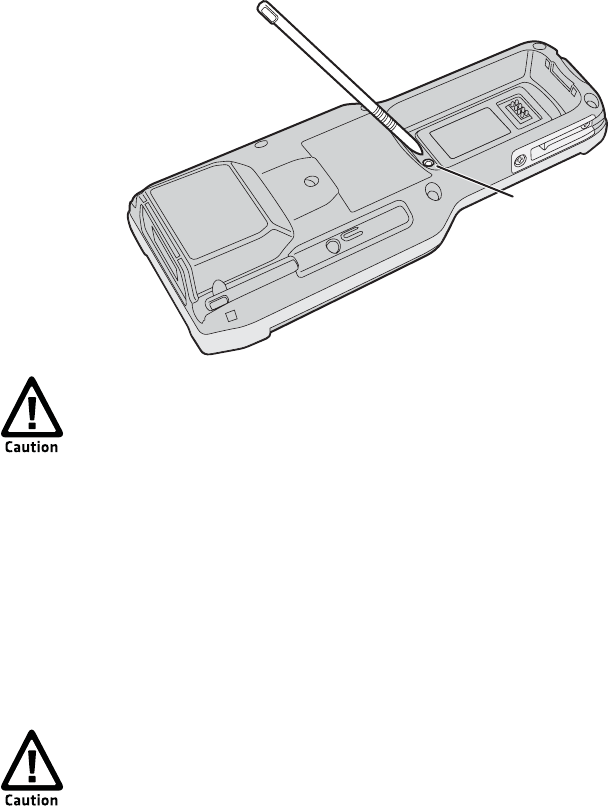
Chapter 4 — Troubleshooting and Maintaining the CK3
74 CK3 Mobile Computer User’s Manual
To cold boot your CK3
1Remove the battery.
2Use the stylus to press the reset button in the battery
compartment of the CK3.
3Replace the battery.
Clean Booting the CK3
If the CK3 does not warm boot or cold boot, you may need to perform
a clean boot. When you clean boot the CK3, the CK3 only loads files
and applications that are absolutely required by the operating system.
Perform a clean boot to get the CK3 up and running so that you can
run diagnostic tests to troubleshoot the normal boot process.
Reset button
Do not use force or a sharp object when pressing the reset
button. You may damage the reset button.
The clean boot process erases the CK3 memory, including all
applications and data files in the object store. To preserve
applications through a clean boot, store them in the Flash File
Store. For more information, see “Installing Applications on the
CK3” on page 53.
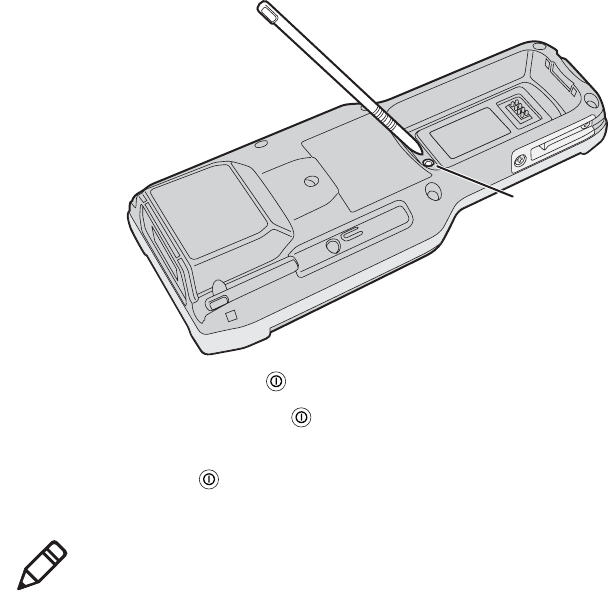
Chapter 4 — Troubleshooting and Maintaining the CK3
CK3 Mobile Computer User’s Manual 75
To clean boot the CK3
1Remove the battery.
2Use the stylus to press the reset button in the battery
compartment of the CK3.
3Press and hold as you replace the battery.
4Continue to hold until the “Clean boot the system?” prompt
appears on screen.
5Release , read the message, and press the appropriate button to
either proceed with the clean boot or cancel the clean boot.
Reset button
Note: You can also clean boot your CK3 from the SmartSystems
console: right-click the CK3 and select Intermec Power Tools >
Clean Boot Device.

Chapter 4 — Troubleshooting and Maintaining the CK3
76 CK3 Mobile Computer User’s Manual
Cleaning the Scanner Window and Screen
To keep the CK3 in good working order, you may need to perform
these minor maintenance tasks:
•Clean the scanner window.
•Clean the CK3 screen.
Clean the scanner window and CK3 screen as often as needed for the
environment in which you are using the computer. To clean the CK3,
use a solution of ammonia and water.
To clean the scanner window and computer screen
1Press to turn off the CK3.
2Dip a clean towel or rag in the ammonia solution and wring out
the excess. Wipe off the scanner window and screen. Do not allow
any abrasive material to touch these surfaces.
3Wipe dry.
There are no user-serviceable parts inside the CK3. Opening the
unit will void the warranty and may cause damage to the internal
components.

77
ASpecifications

Appendix A — Specifications
78 CK3 Mobile Computer User’s Manual
Physical and Environmental Specifications
Physical Dimensions
Length: 21.69 cm (8.54 in)
Width (at widest part): 8.36 cm (3.29 in)
Height (at tallest part): 4.67 cm (1.84 in)
Power and Electrical Specifications
Operating: Rechargeable lithium-ion battery
Backup: Supercap supplies 10 minutes of bridge
time while replacing the main battery
Electrical rating: x 4,4 V, 2A; x 4,7 V, 1,5A
Temperature and Humidity Specifications
Operating temperature: -10°C to 50°C (14°F to 122°F)
Storage temperature: -20°C to 70°C (-4°F to 158°F)
Charging temperature: 0°C to 45°C (32°F to 113°F)
Relative humidity (operating): 0 to 95% non-condensing
Environmental rating: IP54
Screen Specifications
•240 RGB x 320 pixels
•8.9 cm (3.52 in) diagonal square active area, ¼ VGA
•LED backlight with 5 levels of brightness
•LCD capable of both portrait and landscape operation
CK3 Weight
Scan Engine Option With AB17 With AB18
With EV12 14.41 oz 16.32 oz
With EA20X 14.74 oz 16.66 oz
With EX25 15.73 oz 17.64 oz

Appendix A — Specifications
CK3 Mobile Computer User’s Manual 79
Keypad Options
•Alphanumeric and function keypad, available with programmable,
international, 3270 TE/5250 TE, and VT/ANSI TE overlays
•Large numeric and function keypad, available with programmable,
international, 3270 TE/5250 TE, and VT/ANSI TE overlays
Bar Code Symbologies
* These symbologies are only available if your CK3 has an extended
range area imager or a near-far range area imager.
•Australian Post* •GS1 DataBar Limited
•Aztec* •GS1 DataBar Omnidirectional
•BPO (British Post 4-state)* •Interleaved 2 of 5
•ChinaPost •Japan Post*
•CanadaPost •Matrix 2 of 5
•Codabar •Maxicode*
•Codablock A •Micro PDF417
•Codablock F •MSI
•Code 11 •PDF417
•Code 39 •Planet*
•Code 93 •Plessey
•Code 128/GS1-128 •Postnet*
•DataMatrix* •QR Code*
•Dutch Post* •Standard 2 of 5
•EAN/UPC •Telepen
•EAN.UCC Composite •TLC 39
•GS1 DataBar Expanded
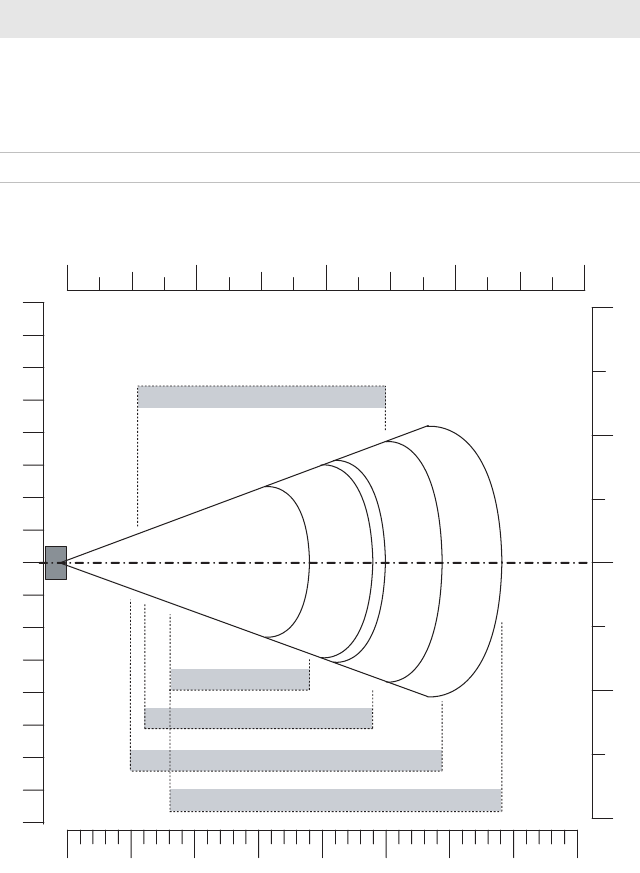
Appendix A — Specifications
80 CK3 Mobile Computer User’s Manual
EV12 Linear Imager Reading Distances
EV12 Linear Imager Minimum Reading Distances: This graphic does not
include the 0.12 cm (0.05 in) setback for the CK3.
Minimum Reading Distances With 0.12 cm (0.05 in) Setback*
Symbology Density Minimum Distance Maximum Distance
Code 39 0.15 mm (6 mils)
0.25 mm (10 mils)
0.5 mm (20 mils)
1 mm (40 mils)
9.6 cm (3.8 in)
7.1 cm (2.9 in)
6.1 cm (2.5 in)
8.1 cm (3.2 in)
17.9 cm (7.1 in)
20.9 cm (8.3 in)
26.9 cm (10.6 in)
33.9 cm (13.4 in)
EAN/UPC 0.33 mm (13 mils) 6.1 cm (2.5 in) 22.9 cm (9.1 in)
*Minimum reading distances are measured in the dark (0 lux).
0"
2"
8"
in
cm
0
10
20
0
"
16
"
12
"
8
"
4
"
0
4
030
2
0
1
0
0.125 mm / 5 mils
0.25 mm / 10 mils
0.5 mm / 20 mils
1 mm / 40 mils
EAN/UPC 100%
5
15
10
20
5
15
6"
4"
5
1
5
2
535
2" 6" 10" 14"
1"
3"
5"
7"
2"
8"
6"
4"
1"
3"
5"
7"
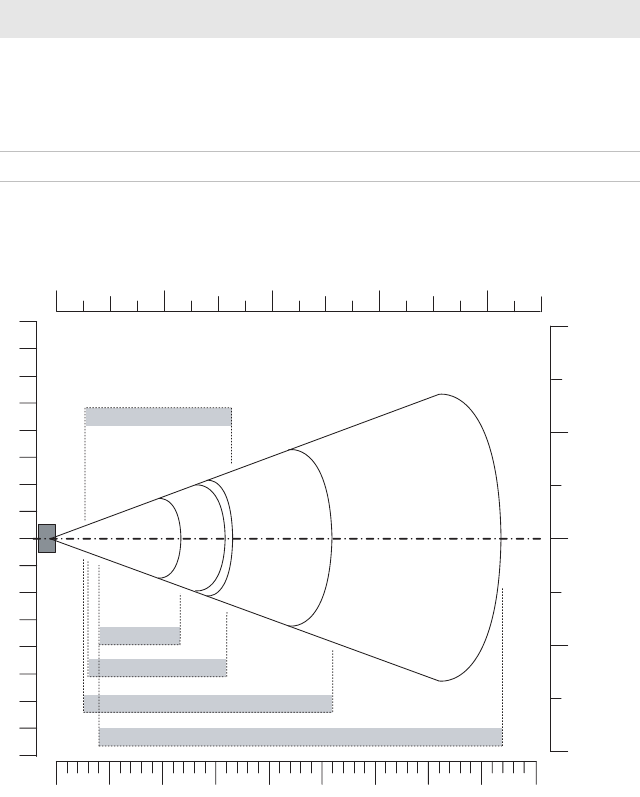
Appendix A — Specifications
CK3 Mobile Computer User’s Manual 81
EV12 Linear Imager Typical Reading Distances: This graphic does not include
the 0.12 cm (0.05 in) setback for the CK3.
Typical Reading Distances With 0.12 cm (0.05 in) Setback*
Symbology Density Minimum Distance Maximum Distance
Code 39 0.15 mm (6 mils)
0.25 mm (10 mils)
0.5 mm (20 mils)
1 mm (40 mils)
9.1 cm (3.6 in)
6.1 cm (2.5 in)
5.1 cm (2.1 in)
7.1 cm (2.9 in)**
19.9 cm (7.9 in)
24.9 cm (9.8 in)
34.9 cm (13.8 in)
50.9 cm (20.1 in)
EAN/UPC 0.33 mm (13 mils) 5.1 cm (2.1 in) 27.9 cm (11.0 in)
* Typical reading distances are measured in an office environment (200 lux).
** Minimum distance depends on bar code width and scan angle.
0"
4"
16"
in
cm
0
20
40
0
"
32
"
24
"
16
"
8
"
0 8060
4
0
2
0
0.125 mm / 5 mils
0.25 mm / 10 mils
0.5 mm / 20 mils
1 mm / 40 mils
EAN/UPC 100%
10
30
20
40
10
30
12"
8"
1
030 50
7
0
4" 12" 20" 28"
2"
6"
10"
14"
4"
16"
12"
8"
2"
6"
10"
14"
90
36"

Appendix A — Specifications
82 CK3 Mobile Computer User’s Manual
EA20X Extended Range Area Imager Minimum Reading
Distances
Minimum Reading Distances With 0.2 cm (0.08 in) Setback*
Symbology Density Minimum Distance Maximum Distance
Code 39 0.15 mm (6 mils)
0.20 mm (8mils)
0.25 mm (10 mils)
0.50 mm (20 mils)
1.00 mm (40 mils)
16.2 cm (6.4 in)
12.2 cm (4.8 in)
9.2 cm (3.6 in)
10.2 cm (4.0 in)
15.2 cm (6.1 in)
21.8 cm (8.6 in)
30.8 cm (12.1 in)
40.8 cm (16.0 in)
70.8 cm (27.9 in)
99.8 cm (99.7 in)
EAN/UPC
100%
0.33 mm (13 mils) 9.2 cm (3.6 in) 47.8 cm (18.8 in)
Data Matrix 0.18 mm (7 mils)
0.25 mm (10 mils)
0.38 mm (15 mils)
17.2 cm (6.8 in)
15.2 cm (6.1 in)
10.2 cm (4.0 in)
19.8 cm (7.8 in)
28.8 cm (11.3 in)
44.8 cm (17.6 in)
PDF417 0.17 mm (6.6 mils)
0.25 mm (10 mils)
0.38 mm (15 mils)
15.2 cm (6.1 in)
10.2 cm (3.9 in)
11.2 cm (4.4 in)
21.8 cm (8.6 in)
32.8 cm (12.9 in)
49.8 cm (19.6 in)
*Minimum reading distances are measured in the dark (0 lux).
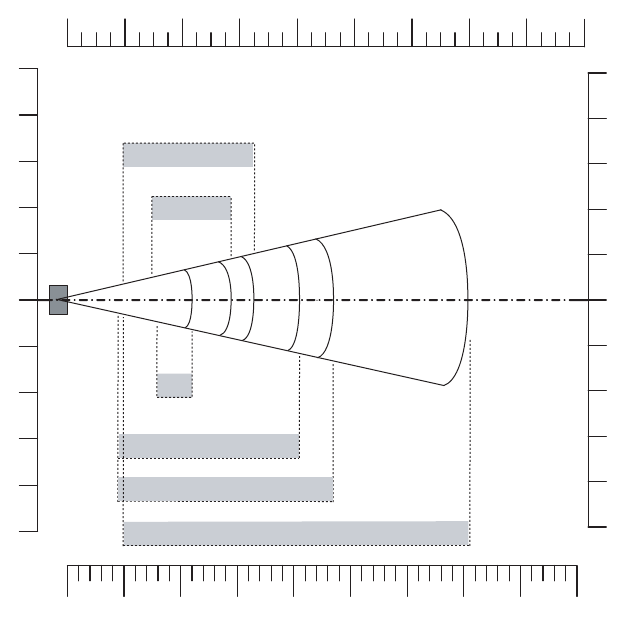
Appendix A — Specifications
CK3 Mobile Computer User’s Manual 83
EA20X Extended Range Area Imager Minimum Reading Distances: This
graphic does not include the 0.2 cm (0.08 in) setback for the CK3.
8"
4"
6"
2"
0"
2"
4"
6"
8"
10"
10"
10
5
0
5
10
15
20
20
15
25
25
cm
PDF417 10 mils
0.15mm/6 mils
0.25 mm / 10 mils
0.5 mm / 20 mils
Data Matrix 10 mils
in
0" 36"32"28"24"20"16"12"8"4"
0 908070605040302010
100% contrast
EAN/UPC

Appendix A — Specifications
84 CK3 Mobile Computer User’s Manual
EX25 Near-Far Range Area Imager Reading Distances.
1D Symbologies Minimum Reading Distances With 0.24 cm (0.09 in)
Setback*
Symbology Density Minimum Distance Maximum Distance
Code 39 0.1 mm (3.8 mils)
0.25 mm (10 mils)
0.5 mm (20 mils)
1 mm (40 mils)
1.3 mm (51 mils)
2.5 mm (100 mils)
18.24 cm (7.18 in)
18.24 cm (7.18 in)
19.24 cm (7.57 in)
40.24 cm (15.84 in)
100.24 cm (39.46 in)
130.24 cm (51.27 in)
31.76 cm (12.51 in)
68.76 cm (27.07 in)
109.76 cm (43.22 in)
219.76 cm (86.52 in)
309.76 cm (121.96 in)
429.76 cm (169.20 in)
EAN 100% 0.33 mm 22.24 cm (7.96 in) 99.76 cm (39.28 in)
* Minimum reading distances are measured in the dark (0 lux).
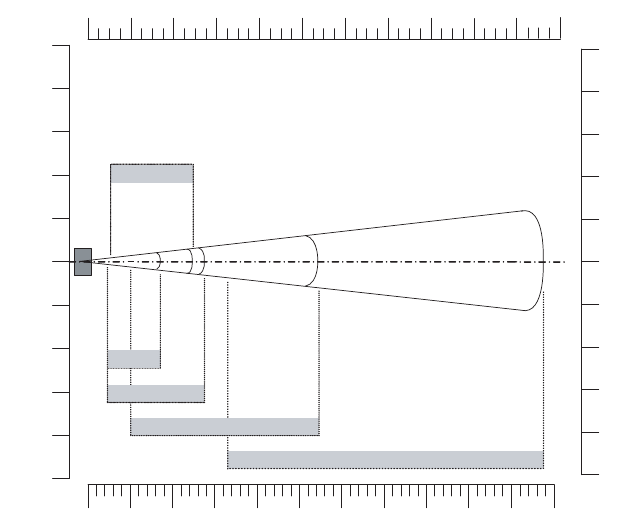
Appendix A — Specifications
CK3 Mobile Computer User’s Manual 85
EX25 Near-Far Range Imager 1D Minimum Reading Distances: This graphic
does not include the 0.24 cm (0.09 in) setback for the CK3.
in
080
40
cm
0" 32"64"80"
16"
100% EAN
contrast UPC 100 cm
39.4"
69 cm
27.2"
110 cm
43.3"
220 cm
86.6"
0.5 mm / 20 mils
1 mm / 40 mils
120 160 200 240 280 320 360 400 440
48"96 " 112"128"144"160"174"
430 cm
169.3"
2.54 mm / 100 mils
32
"
16
48 "
"
"
"
"
"
"
"
64
16
0
80"
"
32
48
64
80
80
40
0
40
80
120
160
160
120
200
200
0.25 mm
10 mils

Appendix A — Specifications
86 CK3 Mobile Computer User’s Manual
1D Symbologies Typical Reading Distances With 0.24 cm (0.09 in)
Setback*
Symbology Density Minimum Distance Maximum Distance
Code 39 0.25 mm (10 mils)
0.5 mm (20 mils)
1 mm (40 mils)
1.4 mm (55 mils)
2.5 mm (100 mils)
16.24 cm (6.21 in)
18.24 cm (7.00 in)
18.24 cm (7.00 in)**
20.24 cm (7.78 in)**
20.24 cm (7.78 in)**
89.76 cm (35.34 in)
179.76 cm (70.77 in)
389.76 cm (153.45 in)
479.76 cm (188.89 in)
869.76 cm (342.43 in)
EAN 100% 0.33 mm 20.24 cm (7.78 in) 109.76 cm (43.22 in)
* Typical reading distances are measured in an office environment (200 lux).
** as long as the bar code label fits in the reading area
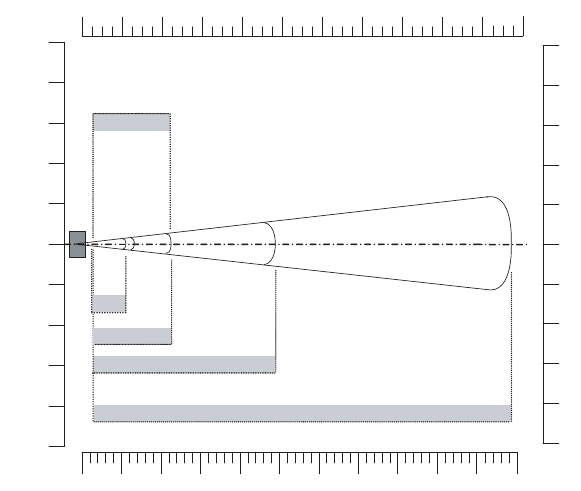
Appendix A — Specifications
CK3 Mobile Computer User’s Manual 87
EX25 Near-Far Range Imager 1D Typical Reading Distances: This graphic does
not include the 0.24 cm (0.09 in) setback for the CK3.
32
"
"
"
"
"
"
in
080
"
"
"
cm
160
80
0
80
160
240
320
320
240
400
400
0"32 "
64 """
390 cm
153.5"
0.25 mm
10 mils
0.5 mm / 20 mils
1 mm / 40 mils
160 240 480 320 560 400 880
"
96 ""
128 ""
160 ""
64
0
870 cm
342.5"
2.54 mm / 100 mils
"
"
32
64
640 720 800
192 224 256 288 320 352
96
128
160
96
128
160
90 cm
35.4"
180 cm
70.9"
100% EAN
contrast UPC 110 cm
43.3"

Appendix A — Specifications
88 CK3 Mobile Computer User’s Manual
2D Symbologies Typical Reading Distances With 0.24 cm (0.09 in)
Setback*
Symbology Density Minimum Distance Maximum Distance
DataMatrix 0.25 mm (10 mils)
1.4 mm (55 mils)
2.5 mm (100 mils)
3.5 mm (140 mils)
5 mm (200 mils)
20.24 cm (7.96 in)**
20.24 cm (7.96 in)**
20.24 cm (7.96 in)**
20.24 cm (7.96 in)**
20.24 cm (7.96 in)**
73.76 cm (29.04 in)
339.76 cm (133.77 in)
679.76 cm (267.63 in)
789.76 cm (310.93 in)
1199.76 cm (472.02 in)
* Typical reading distances are measured in an office environment (200 lux).
** as long as the bar code label fits in the reading area
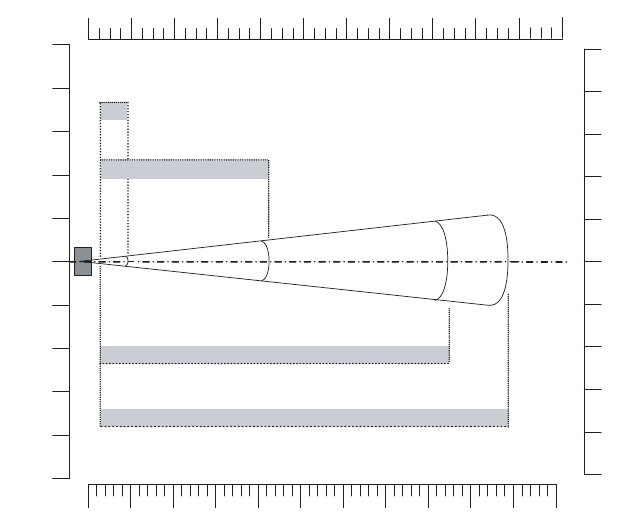
Appendix A — Specifications
CK3 Mobile Computer User’s Manual 89
EX25 Near-Far Range Imager 2D Typical Reading Distances: This graphic
does not include the 0.24 cm (0.09 in) setback for the CK3.
32
"
"
"
"
"
"
in
080
"
"
"
cm
160
80
0
80
160
240
320
320
240
400
400
0"32 "
64 """
680 cm
267.7"
0.25 mm / 10 mils
1.4 mm / 55 mils
2.5 mm / 100 mils
160 240 480 320 560 400 880
"
96 ""
128 ""
160 ""
64
0
790 cm
311"
3.5 mm / 140 mils
"
"
32
64
640 720 800
192 224 256 288 320 352
96
128
160
96
128
160
74 cm
29.1"
340 cm
133.9"
Appendix A — Specifications
90 CK3 Mobile Computer User’s Manual
Accessories
You can use these accessories (sold and ordered separately) with
the CK3. To order accessories, contact your local Intermec sales
representative.
Battery (AB17, AB18)
The AB17 standard battery and AB18 extended battery provide main
power to the CK3.
Quad Charger (AC20)
The AC20 quad charger charges up to four CK3 batteries at one time.
Single Dock (AD20)
The AD20 single dock charges a spare CK3 battery and powers your
CK3 while providing communications through a serial, USB client, or
USB host adapter port.
Ethernet Multidock (AD21)
The AD21 ethernet multidock provides ethernet connectivity and
power to up to four CK3 computers at one time.
Charge-Only Multidock (AD22)
The AD22 charge-only multidock charges up to four CK3 computers
at one time.
Vehicle Dock (AV10)
Use the AV10 vehicle dock to hold and charge your CK3 while you are
using it on a vehicle.
Vehicle Battery Adapter (AE33)
Use the AE33 vehicle battery adapter to provide power to your CK3
from your vehicle. To use the vehicle battery adapter, you also need
the AA23 power adapter.
Audio Adapter (AA20)
Use the audio adapter to connect an audio device, such as a headset,
to your CK3.
RS-232 Adapter (AA21)
Use the RS-232 adapter to connect RS-232 devices to your CK3.
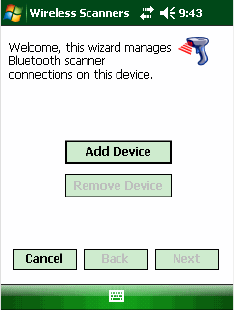
Chapter 2 — Connecting and Configuring the CK3
CK3 Mobile Computer User’s Manual 31
Connecting to a Bluetooth Scanner
You can connect to an Intermec Bluetooth scanner, such as the SF51
or SR61, using one of these methods:
•Scan the association bar code label that ships with the CK3.
•Run the Wireless Scanning Wizard.
To connect to a Bluetooth scanner with the association label
1Make sure that the Bluetooth radio on your CK3 is enabled and
that your CK3 is visible and connectable.
2Make sure that your Bluetooth scanner is on.
3With your Bluetooth scanner, scan the Bluetooth association bar
code label that ships with the CK3.
4When prompted, enter the passcode for your scanner. The default
passcode for Intermec Bluetooth scanners is 0000.
5Tap Finish.
To connect to a Bluetooth scanner with the Wireless Scanning Wizard
1Select Start > Settings > the System tab > Wireless Scanning.
2Follow the onscreen instructions to connect to a scanner.

Chapter 2 — Connecting and Configuring the CK3
32 CK3 Mobile Computer User’s Manual
Configuring Bluetooth Communications for Wireless
Printing
To configure your CK3 for Bluetooth wireless printing, you need to:
•make sure Bluetooth power is on. For help, see the procedure in
“Configuring Bluetooth Communications” on page 29.
•create an application that opens the wireless printing COM port
on your CK3. For help, see the Bluetooth Resource Kit, part of the
Intermec Developer Library (IDL), available from the Intermec
web site at www.intermec.com/idl.
•select the current wireless printer on the CK3. For help, see the
next procedure.
To select the current wireless printer
1Select Start > Settings > the System tab > Wireless Printing.
2Tap Search to find a printer, or tap Manual to enter a device
address. Follow the onscreen instructions to select the current
wireless printer.
3(Optional) Tap Print Test Page. The printer prints out the test
page.
Note: You can also print wirelessly using Microsoft APIs with
Bluetooth extensions for Winsock and Bluetooth virtual COM ports.
For help, see the IDL, available from the Intermec web site at
www.intermec.com/idl.
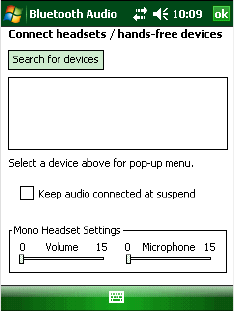
Chapter 2 — Connecting and Configuring the CK3
CK3 Mobile Computer User’s Manual 33
Connecting to a Bluetooth Audio Device
Use the Bluetooth Audio applet to discover, activate, and connect to
Bluetooth audio devices such as a Bluetooth headset.
To connect to a Bluetooth audio device
1Select Start > Settings > the System tab > Bluetooth Audio. The
Bluetooth Audio screen appears.
2Follow the onscreen instructions to connect to a Bluetooth audio
device.
Configuring Ethernet Communications
You connect your CK3 to your Ethernet network with an ethernet
cable and one of these accessories:
•AD20 single dock with an AA12 ethernet adapter
•AD21 ethernet multidock
To use your CK3 in an Ethernet network
1Connect your CK3 to an ethernet network with an AD20 or AD21.
Ethernet communications is automatically enabled on your CK3.
2Configure these network parameters:
•If you have a DHCP server, enable DHCP.
•If you do not have a DHCP server, set these parameters:
aIP address
bSubnet mask

Chapter 2 — Connecting and Configuring the CK3
34 CK3 Mobile Computer User’s Manual
cDefault router
3If necessary, set these parameters:
•Primary and secondary DNS servers
•Primary and secondary WINS servers
4Make sure that your CK3 is communicating with the network and
that the network can see your CK3.
Using Serial and USB Communications
You can use these CK3 accessories to transmit data to and receive data
from another device through serial or USB communications:
•AD20 single dock
•AV10 vehicle dock
•AA21 RS-232 adapter
For more information about these accessories and how to order them,
see “Accessories” on page 90.
Checking the Status of Your Wireless Connection
After you configure your wireless settings, you can use iConnect to
check the status of your connection. You can also use iConnect to
configure the network settings and test the connection of your CK3
against the network.
To check the status of your wireless connection
1Tap the iConnect icon ( ) in the lower right corner of the Today
screen.
2From the iConnect menu, select Status > Wireless. The Wireless
Status screen appears and checks the connection.
To configure the network settings
•From the iConnect menu, tap Tools > Wireless Settings.
To test the connection of your CK3 against your network
•From the iConnect menu, select Tools > Ping Test.
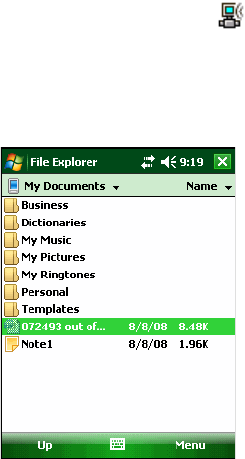
Chapter 2 — Connecting and Configuring the CK3
CK3 Mobile Computer User’s Manual 35
Viewing Detailed 802.11b/g Radio Connection Information
Use the ISpyWiFi utility to view detailed information for your 802.11
radio connection. You can also use ISpyWiFi to scan for access points
in your network and ping for detailed information.
You start the ISpyWiFi utility using the iConnect icon or File
Explorer. With File Explorer, you can also create a shortcut to start the
utility from the CK3 desktop.
To start the ISpyWiFi utility
•Tap the iConnect icon ( ) in the lower right corner of the Today
screen and select Status > Wireless > the Advanced button.
Or,
1Tap Start > File Explorer.
2Tap the arrow next to My Documents and select My Device.
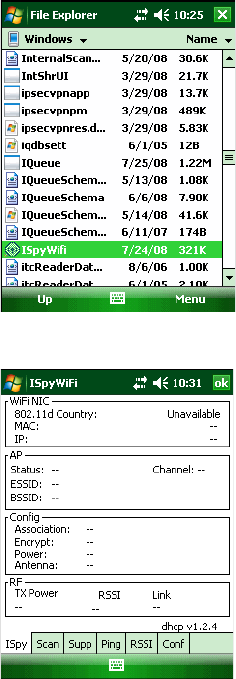
Chapter 2 — Connecting and Configuring the CK3
36 CK3 Mobile Computer User’s Manual
3Tap the Windows folder and scroll down to find ISpyWiFi.
4Tap ISpyWifi. The ISpyWiFi utility starts.
To add an ISpyWiFi shortcut to the CK3 Programs folder
1Tap and hold your stylus on the ISpyWiFi executable until the
pop-up menu appears.
2Select Copy from the pop-up menu.
3Navigate to the Windows\Start Menu\Programs folder.
4Tap and hold the stylus in the empty area at the bottom of the
screen until the pop-up menu appears.
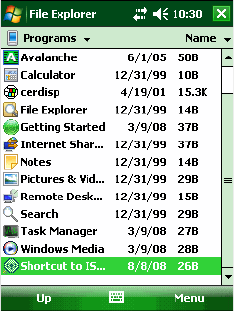
Chapter 2 — Connecting and Configuring the CK3
CK3 Mobile Computer User’s Manual 37
5Select Paste Shortcut.
6Close File Explorer.
7Select Start > Programs. The ISpyWiFi shortcut appears in the
programs list.
For more information about the ISpyWiFi tabs, see “Understanding
ISpyWiFi” on page 92.
Configuring Wireless Security
The CK3 provides four types of security for your wireless network:
•Wi-Fi Protected Access 2 (WPA2™)
•Wi-Fi Protected Access (WPA)
•802.1x
•WEP
This section explains how to configure wireless security on your CK3.
If you choose not to use security, see “Disabling Security” on
page 49. Intermec always recommends that you implement security.
You must use either Funk or Microsoft security to implement your
security solution. For details, see the next section, “Choosing
Between Funk and Microsoft Security.”

Chapter 2 — Connecting and Configuring the CK3
38 CK3 Mobile Computer User’s Manual
If you are using WPA-802.1x, WPA2-802.1x, or 802.1x security, this
section also assumes that your authentication server and
authenticators are properly configured. For more information on
802.1x security, see the MobileLAN™ secure 802.1x Security Solution
Installation Guide (P/N 073134) available at www.intermec.com.
Choosing Between Funk and Microsoft Security
The CK3 supports both Funk and Microsoft security. The option you
choose depends on your network security needs.
Note: Your security choice does not depend on your authentication
server. For example, you can choose Funk security if you use
Microsoft Active Directory® to issue certificates.
Understanding Microsoft and Funk Security
Security Choice Description
Microsoft Microsoft security dynamically selects wireless networks
based on your preferences. If you are primarily using the
CK3 to connect to WiFi hotspots, you may want to use
Microsoft security.
To use Microsoft security, you need to select it as your
security choice. For help, see “Selecting Microsoft as
Your Security Choice” on page 43.
Funk (default) Funk security offers features that are similar to Microsoft
security, but Funk also offers these features:
•CCX v2.0 compliance
•Support for LEAP and TTLS
•Configuration of up to four profiles
If you are using the CK3 in a static environment that
requires a high level of security, you should use Funk
security.
To use Funk security, you need to select a profile. For help,
see the next section, “Selecting a Funk Security Profile.”

Chapter 2 — Connecting and Configuring the CK3
CK3 Mobile Computer User’s Manual 39
Selecting a Funk Security Profile
You can define up to four profiles for Funk security. Different profiles
let your CK3 communicate in different networks without having to
change all of your security settings. For example, you may want to set
up one profile for the manufacturing floor and one for the
warehouse. By default, the active profile is Profile 1.
To select a Funk security profile
1Start Intermec Settings.
2Choose Communications > 802.11 Radio > Funk Security.
3Tap a profile to expand it.
4(Optional) In the Profile Label text box, enter a meaningful name
for your profile.
5Configure your security settings. For help, see the next sections.
6Repeat Steps 3 through 5 for each profile you want to define.
7Select one profile as the active profile by tapping Active Profile
and choosing a profile from the list.
8Save your settings.
Configuring WPA Security With Funk Security
Use these procedures to set WPA-802.1x, WPA2-802.1x, WPA-PSK, or
WPA2-PSK security on your CK3 with Funk security.
To configure WPA-802.1x or WPA2-802.1x with Funk security
1Make sure the communications and radio parameters on your
CK3 are configured.
2Make sure Funk is selected as your security choice.
3Start Intermec Settings.
4Choose Communications > 802.11 Radio > Funk Security.
5Select the profile you want to configure.
Note: You can also use the Profile Wizard to configure most wireless
security settings. To start the Profile Wizard, tap the iConnect icon
( ) in the lower right corner of the Today screen and select Tools >
Wireless Settings.

Chapter 2 — Connecting and Configuring the CK3
40 CK3 Mobile Computer User’s Manual
6For Association, choose WPA or WPA2. Encryption
automatically defaults to TKIP or AES, respectively.
7For 8021x, choose TTLS, PEAP, EAP-FAST, or TLS and press
Enter.
8If you choose TTLS or PEAP:
aFor Prompt for Credentials, choose Enter credentials now.
bTap User Name, enter your user name, and press Enter.
cTap User Password, enter your password, and press Enter.
dFor Validate Server Certificate, choose Yes and press Enter.
If you choose TLS:
aLoad a user and root certificate on your CK3. For help, see
“Loading a Certificate” on page 47.
bEnter a User Name and Subject Name.
cFor Validate Server Certificate, choose Yes and press Enter.
d(Optional) To increase your level of security, enter a Server 1
Common name and a Server 2 Common name.
9Save your settings and exit Intermec Settings.
To configure WPA or WPA2 with Funk security
1Make sure the communications and radio parameters on your
CK3 are configured.
2Make sure Funk is selected as your security choice.
3Start Intermec Settings.
4Choose Communications > 802.11 Radio > Funk Security.
5Select the profile you want to configure.
6For Association, choose WPA or WPA2 and press Enter.
Note: You can use Prompt for Credentials to troubleshoot
your network connection.
Note: The correct date must be set on your CK3 when you
enable Validate Server Certificate.

Chapter 2 — Connecting and Configuring the CK3
CK3 Mobile Computer User’s Manual 41
7For 8021x, choose None and press Enter.
8For Pre-Shared Key, enter the pre-shared key or passphrase.
The pre-shared key must be a value of 32 hex pairs preceded by 0x
for a total of 66 characters. The value must match the key value on
the access point. The passphrase must be from 8 to 63 characters.
After you enter a passphrase, the CK3 internally converts it to a
pre-shared key.
This value must match the passphrase on the authenticator.
9Save your settings and exit Intermec Settings.
Configuring 802.1x Security With Funk Security
1Make sure the communications and radio parameters on your
CK3 are configured.
2Make sure Funk is selected as your security choice.
3Start Intermec Settings.
4Choose Communications > 802.11 Radio > Funk Security.
5Select the profile you want to configure.
6For Association, choose Open and press Enter.
7For Encryption, choose WEP and press Enter.
8For Authentication, choose TTLS, PEAP, or TLS and press
Enter.
9If you choose TTLS or PEAP:
aTap User Name, enter your user name, and press Enter.
bTap Password prompt, choose Enter password now, and
press Enter.
cTap User Password, enter your password, and press Enter.
dFor Validate Server Certificate, choose Yes and press Enter.
Note: You can use Password prompt to troubleshoot your
network connection.
Chapter 2 — Connecting and Configuring the CK3
42 CK3 Mobile Computer User’s Manual
If you choose TLS:
aLoad a user and root certificate on your CK3. For help, see
“Loading a Certificate” on page 47.
bFor Validate Server Certificate, choose Yes and press Enter.
cEnter a User Name and Subject Name.
d(Optional) To increase your level of security, enter a Server 1
Common name and a Server 2 Common name.
10 Save your settings and exit Intermec Settings.
Configuring LEAP Security on Your CK3
1Make sure the communications and radio parameters on your
CK3 are configured.
2Make sure Funk is selected as your security choice.
3Start Intermec Settings.
4Choose Communications > 802.11 Radio > Funk Security.
5Select the profile you want to configure.
6For 8021x, choose LEAP and press Enter.
7For Association, choose Open, WPA, WPA2, or Network EAP
and press Enter. Encryption automatically defaults to TKIP if you
choose WPA, AES if you choose WPA2, and WEP if you choose
Open or Network EAP.
8For Prompt for Credentials, choose Enter credentials now.
9Tap User Name, enter your user name, and press Enter.
10 Tap User Password, enter your password, and press Enter.
11 Save your settings and exit Intermec Settings.
Configuring Static WEP Security With Funk Security
1Make sure the communications and radio parameters on your
CK3 are configured.
2Make sure Funk is selected as your security choice.
3Start Intermec Settings.
4Choose Communications > 802.11 Radio > Funk Security.
5Select the profile you want to configure.
Chapter 2 — Connecting and Configuring the CK3
CK3 Mobile Computer User’s Manual 43
6For Association, choose Open and press Enter.
7For Encryption, choose WEP and press Enter.
8For 8021x, choose None.
9Define a value for the keys you want to use. You can define up to
four keys (Key 1 through Key 4).
Enter an ASCII key or a hex key that is either 5 bytes or 13 bytes
long depending on the capability of the radio. Set a 5- byte value
for 64-bit WEP or a 13-byte value for 128-bit WEP. Hex keys must
be preceded by 0x and contain 5 or 13 hex pairs.
10 For Transmit key, choose the key you want to use for
transmitting data.
11 Save your settings and exit Intermec Settings.
Selecting Microsoft as Your Security Choice
The default security setting is Funk. If you want to use Microsoft
security, you need to select it as your security choice. After you select
Microsoft as your security choice, you will be prompted to save your
settings and reset your CK3 for your change to take effect.
With Microsoft as your security choice, you can configure:
•WPA
•802.1x
•Static WEP
To select Microsoft security as your security choice
1Select Start > Settings > the System tab > Intermec Settings. The
Intermec Settings application appears.
2Select Communications > 802.11 Radio > Security Choice.
3From the Security Choice list, select Microsoft Security and save
your settings. An alert box appears telling you that you must save
your settings and warm boot the CK3 for the new security choice
to take effect.
4Tap Yes. The CK3 resets and starts with Microsoft Security as the
Security Choice.
Chapter 2 — Connecting and Configuring the CK3
44 CK3 Mobile Computer User’s Manual
Configuring WPA Security With Microsoft Security
Use these procedures to set WPA-802.1x and WPA-PSK security on
your CK3 with Microsoft security.
To enable WPA-802.1x with Microsoft security
1Make sure the communications and radio parameters on your
CK3 are configured.
2Start Intermec Settings.
3Choose Communications > 802.11 Radio > Microsoft Security.
4For Infrastructure Mode, choose Infrastructure.
5For Network Authentication, choose WPA. Data Encryption
automatically defaults to TKIP.
6For 802.1x Authentication, choose either TLS or PEAP.
7If you choose TLS:
aSelect Properties and tap the Run App button. The Auth.
Settings dialog box appears.
bTap the Select button.
cSelect your certificate from the list and press Enter. The User
Logon dialog box appears.
dEnter a User Name and Domain and press Enter.
If you choose PEAP:
aSelect Properties and tap the Run App button. The Auth.
Settings box appears.
bSelect Validate Server and press Enter. When the radio starts
to authenticate, the Network Password dialog box appears.
cEnter a User Name and Password and select Save Password.
d(Optional) In the Domain field, enter the Active Directory
domain associated with the user account.
ePress Enter.
8Save your settings and exit Intermec Settings.
Chapter 2 — Connecting and Configuring the CK3
CK3 Mobile Computer User’s Manual 45
To enable WPA-PSK With Microsoft Security
1Make sure the communications and radio parameters on your
CK3 are configured.
2Start Intermec Settings.
3Choose Communications > 802.11 Radio > Microsoft Security.
4For Infrastructure Mode, choose Infrastructure.
5For Network Authentication, choose WPA-PSK. Data
Encryption automatically defaults to TKIP.
6For Pre-Shared Key, enter the pre-shared key or the passphrase.
The pre-shared key must be a value of 32 hex pairs preceded by
0x for a total of 66 characters. The value must match the key value
on the authenticator. The passphrase must be from 8 to 63
characters. After you enter a passphrase, the CK3 internally
converts it to a pre-shared key.
This value must match the passphrase on the authenticator.
7Save your settings and exit Intermec Settings.
Configuring 802.1x Security With Microsoft Security
1Make sure the communications and radio parameters on your
CK3 are configured.
2Start Intermec Settings.
3Choose Communications > 802.11 Radio > Microsoft Security.
4For Infrastructure Mode, choose Infrastructure.
5For Network Authentication, choose Open.
6For Data Encryption, choose WEP.
7For 802.1X Authentication, choose TLS or PEAP.
8If you choose TLS:
aSelect Properties and tap the Run App button. The Auth.
Settings box appears.
bTap the Select button.
cSelect your certificate from the list and press Enter. The User
Logon dialog box appears.
Chapter 2 — Connecting and Configuring the CK3
46 CK3 Mobile Computer User’s Manual
dEnter a User Name and a Domain. and press Enter.
If you choose PEAP:
aSelect Properties and tap the Run App button. The Auth.
Settings box appears.
bSelect Validate Server and press Enter. When the radio starts
to authenticate, the Network Password dialog box appears.
cEnter a User Name and Password and select Save Password.
d(Optional) In the Domain field, enter the domain.
ePress Enter.
9For Network Key Setting, choose Automatic.
10 Save your settings and exit Intermec Settings.
Configuring Static WEP Security With Microsoft Security
1Make sure the communications and radio parameters on your
CK3 are configured.
2Start Intermec Settings.
3Choose Communications > 802.11 Radio > Microsoft Security.
4For Network Authentication, choose Open.
5For Data Encryption, choose WEP.
6For Network Key Setting, choose Enter Key and Index.
7For Network Key Value, enter an ASCII key or a hex key that is
either 5 bytes or 13 bytes long depending on the capability of the
radio.
Set a 5-byte value for 64-bit WEP or a 13-byte value for 128-bit
WEP. Hex keys must be preceded by 0x and contain 5 or 13 hex
pairs.
8For Network Key Index, select the key you want to use for data
transmission.
9Save your settings and exit Intermec Settings.
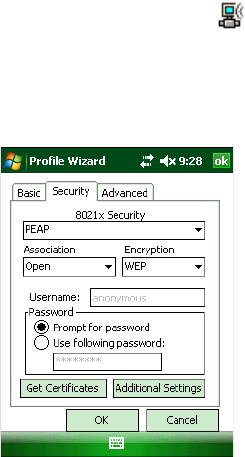
Chapter 2 — Connecting and Configuring the CK3
CK3 Mobile Computer User’s Manual 47
Loading a Certificate
If you choose to use transport layer security (TLS) with WPA or 802.1x
security, you need a unique client certificate on the CK3 and a trusted
root certificate authority (CA) certificate. Certificates are pieces of
cryptographic data that guarantee a public key is associated with a
private key. They contain a public key and the entity name that owns
the key. Each certificate is issued by a certificate authority.
To import a certificate
1Tap the iConnect icon ( ) in the lower right corner of the Today
screen. The iConnect pop-up menu appears.
2Select Tools > Wireless Settings. The Profile Wizard appears.
3Tap Edit Selected Profile > the Security tab.
4For 8021x Security, select PEAP, TLS, or TTLS.
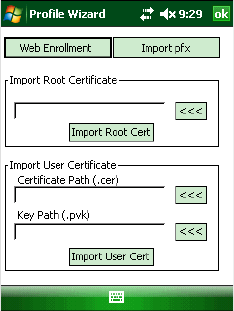
Chapter 2 — Connecting and Configuring the CK3
48 CK3 Mobile Computer User’s Manual
5Tap Get Certificates.
6To import a root certificate:
aTap the <<< button next to the Import Root Certificate field
to select the root certificate (DER-encoded .cer file) to import.
bClick Import Root Cert to install the selected certificate.
To import a user certificate:
aTap the <<< button next to the Certificate Path field to select
the user certificate (DER-encoded .cer file without the private
key) to import.
bTap the <<< button next to the Key Path field to select the
private key (.pvk file) which corresponds to the user certificate
you selected.
To import a certificate from an IAS server:
aTap Web Enrollment.
bEnter the User, Password, and Server (IP address) to log into
the server.
cTap OK. A dialog box appears asking if you want to load the
root certificate.
dTap OK. The Enrollment Tool message box appears telling you
that the certificate has been added.
eTap OK to close the message box.
Chapter 2 — Connecting and Configuring the CK3
CK3 Mobile Computer User’s Manual 49
Disabling Security
If you choose not to use security with your wireless network, you can
disable it on the CK3. Intermec recommends that you always set
security in your network.
To disable security
1Open Intermec Settings.
2Choose Communications > 802.11 Radio > Microsoft Security.
3For Network Authentication, choose Open.
4For Data Encryption, choose Disabled.
5Close Intermec Settings.
Chapter 2 — Connecting and Configuring the CK3
50 CK3 Mobile Computer User’s Manual

51
3Developing and Installing
Applications
This chapter contains guidelines for developing
applications for the CK3 and contains these sections:
•Developing Applications for the CK3
•Installing Applications on the CK3
•Freeing Up Virtual Memory for Applications
•Launching an Application Automatically
•Upgrading the System Software
Chapter 3 — Developing and Installing Applications
52 CK3 Mobile Computer User’s Manual
Developing Applications for the CK3
The CK3 runs applications programmed in Microsoft Visual Studio
2005. You can also use Microsoft eMbedded Visual C++ 4.0 to
program applications, but some features may not be available. Use
this section to understand the hardware and software you need to
develop applications for the CK3.
Use the Intermec resource kits to develop new applications to run on
the CK3. The Intermec resource kits are a library of C++ and .NET
components grouped by functionality that you can use to create
applications for the computer. The resource kits are part of the
Intermec Developer Library (IDL), and can be downloaded from the
Intermec IDL web site at www.intermec.com/idl.
To use the resource kits, you need these hardware and software
components:
•Pentium desktop, 400 MHz or later
•Windows 2000 (Service Pack 2 or later) or Windows XP (Home,
Professional, or Server)
•For native and managed development, Microsoft Visual Studio
2005
•128 MB RAM (196 MB recommended)
•360 MB hard drive space for minimum installation (720 MB for
complete)
•CD-ROM drive compatible with multimedia desktop specification
•VGA or higher-resolution monitor (Super VGA recommended)
•Microsoft Mouse or compatible pointing device
Chapter 3 — Developing and Installing Applications
CK3 Mobile Computer User’s Manual 53
Installing Applications on the CK3
You can install applications on your CK3 using one of these methods:
•Package your application as a cabinet (.cab) file.
•Send the .exe file (simple applications, only) to the CK3.
•Copy a directory structure that contains the application,
supporting files, DLLs, images, and data files.
Intermec recommends using .cab files to install your applications.
The CK3 uses standard Windows Mobile .cab files and can install
third-party .cab files. You can program your .cab file to install your
application to one of these memory locations on your CK3:
•Object Store or Flash File Store. The Object Store is a
DiskOnChip® flash that looks like a disk. The Flash File Store is
an area of storage which is embedded in a section of the system
flash memory. This storage is not erased during a reset, although
it may be erased during the reflashing process. In addition to
storing applications and data files, you can also store persistent
registry information to the Flash File Store region.
•Optional microSD card. If you are using a microSD card, this
should be the primary location to place application installation
files. The microSD card creates the Storage Card folder (SDMMC)
on the CK3. For help using a microSD card, see “Using a
microSD Card” on page 21.
•Non-volatile Flash File Store. Use the small non-volatile Flash File
Store region to hold .cab files that rebuild the system at clean boot
or install applications from a .cab file into the Flash File Store so
that they are “ready-to-run” when you perform a clean boot. The
flash in the system has a limited number of write cycles, so do not
use the Flash File Store for excessive writing.
Files copied to any of these locations are safe when you cold boot the
CK3 as long as the AutoRun system is installed in the appropriate
location. For more information about AutoRun, see the Intermec
Developer’s Library (IDL) Resource Kit Developer’s Guide available
from www.intermec.com/idl.
When you copy a .cab file to the \CabFiles folder, the folder
automatically extracts that .cab file on every cold boot.
Chapter 3 — Developing and Installing Applications
54 CK3 Mobile Computer User’s Manual
You can use these methods to install files and applications on your
CK3:
•SmartSystems Foundation
•ActiveSync
•microSD card
•FTP server
•Wavelink Avalanche
The following sections explain how to use each process to install your
application on the CK3.
Installing Applications Using SmartSystems Foundation
Your CK3 is SmartSystems-enabled, which lets you use the
SmartSystems console to install Intermec applications on your
CK3. The console is part of SmartSystems Foundation. For more
information, go to the Intermec web site at www.intermec.com/
SmartSystems.
To install an application using the SmartSystems console
1Download the application to your PC.
2Double-click the application. The application appears in the
SmartSystems console in the Software Vault.
3Drag the application to each CK3 in your network or to a group of
CK3s in a folder.
Installing Applications Using Microsoft ActiveSync
You can send applications from your PC to your CK3 using Microsoft
ActiveSync.
To install an application using Microsoft ActiveSync
1On your PC, copy the .cab file you want to download to your CK3.
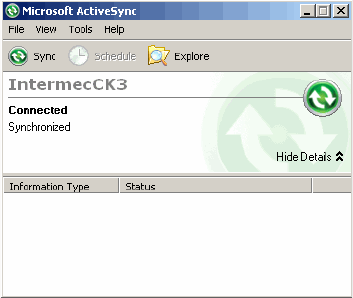
Chapter 3 — Developing and Installing Applications
CK3 Mobile Computer User’s Manual 55
2Create an ActiveSync connection between your PC and CK3. For
help, see “Connecting to a PC” on page 26.
3Click Explore. The Mobile Device window opens.
4Double-click My Windows Mobile-Based Device.
5Navigate to the folder you want to copy the .cab file to, and paste
the .cab file in the folder.
6Clean boot the CK3. For help, see “Clean Booting the CK3” on
page 74.
7On your CK3, tap Start > Programs > File Explorer and navigate
to the location of the .cab file.
8Tap the .cab file to install it.
Installing Applications Using a microSD Card
Using a microSD card is the best method for installing applications.
To install applications using the storage card
1Suspend the CK3 and remove the microSD card.
2Insert the microSD card into a microSD adapter card and then
place it in the storage card reader connected to your PC.
3Copy your application file to the microSD card.
4Remove the microSD card from the adapter card and insert it into
the CK3.
Chapter 3 — Developing and Installing Applications
56 CK3 Mobile Computer User’s Manual
5On your CK3, navigate to the storage card folder and run your
application.
Installing Applications Using the FTP Server
The CK3 has a built-in FTP Server that connects to a network through
Ethernet, 802.11 b/g, or Bluetooth communications. You can use the
server to transfer your application file to the computer. Another
benefit of using the FTP server is that you can create FTP scripts to
automate the process of copying your files to the computer. This
option is useful when you need to send files to a large number of
computers.
The easiest way to manage the FTP server is to enable the FTP menu
within iConnect.
To enable the FTP menu
•Create this DWORD registry key and set it to a value of 1:
HKEY_CURRENT_USER\Software\iConnect2\IConnect\Settings\ShowFTPMenu
The iFTP menu is available the next time your start iConnect.
To manage the state of the FTP server
•Modify these existing registry keys:
HKEY_CURRENT_USER\Software\iConnect2\IConnect\Settings\FtpAutoStart
HKEY_CURRENT_USER\Software\iConnect2\IConnect\Settings\FtpHeartbeat
Where 1 = enable and 0 = disable.
Installing Applications Using Wavelink Avalanche
You can use the Wavelink Avalanche device management system to
install applications on all of your wireless CK3 computers. To use
Wavelink Avalanche, you need to install the Avalanche Enabler on
your CK3.
To install the Avalanche Enabler on your CK3
1Tap Start > File Explorer > Windows > InstallSelect. The
InstallSelect utility starts.
2Make sure that Avalanche Enabler is selected.
3Tap Apply. You CK3 clean boots and Avalanche Enabler is
installed.

Chapter 3 — Developing and Installing Applications
CK3 Mobile Computer User’s Manual 57
Each time the Avalanche Enabler is activated (typically on a reset), the
CK3 attempts to connect to the Avalanche Agent. When the CK3
connects to the agent, the agent determines whether an update is
available and immediately starts the software upgrade, file transfer, or
configuration update.
To remotely manage the CK3 with Avalanche
1Install software packages and updates for the CK3 using the
Avalanche Administrative console.
2Schedule the CK3 updates or manually initiate an update using
the Avalanche Administrative console.
For more information on using Wavelink Avalanche, contact your
local Intermec representative or visit the Wavelink web site at
www.wavelink.com.
Freeing Up Virtual Memory for Applications
You can use the InstallSelect application to free up virtual memory
and create more space to load and run custom applications.
When you free up virtual memory, you reduce the amount of virtual
memory used by portions of the SmartSystems Platform Bundle
(SSPB) by removing value-added software features. Be sure to back up
any related files that you want before you use the InstallSelect
application. For more information on SSPB, see “Upgrading the
System Software” on page 61.
Note: If you manually activate the Avalanche Enabler on the CK3, you
may be prompted for a password when you exit the Avalanche
Enabler. The default password is leave.
Note: InstallSelect is designed for use only by administrators,
developers, integrators, or Intermec service representatives. Do not
run InstallSelect while using any other applications.
Removing software features may result in loss of computer
functionality or the ability to manage device settings. Contact
your Intermec service representative for information about each
software feature before making changes.
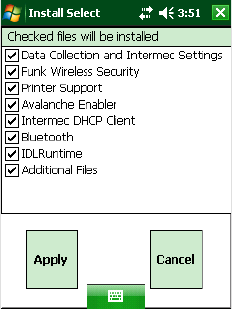
Chapter 3 — Developing and Installing Applications
58 CK3 Mobile Computer User’s Manual
To free up virtual memory
1Go to Start > Programs > File Explorer.
2Tap the arrow next to My Documents and select My Device.
3Tap the Windows folder and scroll down to find InstallSelect.
4Tap InstallSelect. The Install Select application starts and
displays a Caution message box.
5Tap OK to close the box.
6Clear the check box of any components you do not want installed
after a clean boot. For a description of each component, see the
next table.
By default, components already installed on the computer are
automatically checked to be installed again after you perform a
clean boot.
7Tap Apply to initiate the clean boot and install only the files that
are selected.

Chapter 3 — Developing and Installing Applications
CK3 Mobile Computer User’s Manual 59
8Tap Yes to continue with the clean boot. The computer performs a
clean boot and restarts with all of the checked components
installed.
Depending on the options you selected for your CK3, you may see
other components available from the InstallSelect application.
Launching an Application Automatically
There are two ways to automatically launch your application when
you perform a reset on the computer:
•Make sure your .cab file places a shortcut to your application in
the \Windows\StartUp folder.
•Configure AutoRun.exe to launch your application.
AutoRun.exe automates operations on your CK3. You can configure
AutoRun.exe through the AutoRun data file (AutoRun.dat). For
compatibility with other Intermec computers, you can place a copy of
AutoRun.exe in the same folder as your AutoRun.dat file.
InstallSelect Software Components
Component Name Description
Data Collection &
Intermec Settings
Data collection and Intermec Settings. Also includes
on-unit SDK libraries.
If you disable this .cab file, you cannot scan or collect
data on the device and you cannot use Intermec
Settings.
Funk Wireless
Security
Intermec security supplicant that provides a wireless
security solution with several features that are not
supported by Microsoft.
Printer Support Provides Intermec printer driver support.
Intermec DHCP
Client
Provides the Intermec DHCP client application.
Bluetooth Provides the Intermec Bluetooth application support.
Avalanche Enabler Enables the client to the Wavelink Device Management
solution.

Chapter 3 — Developing and Installing Applications
60 CK3 Mobile Computer User’s Manual
To create and install the AutoRun.dat file on your computer
1Create a folder called System on your CK3.
2On your PC, open the Notepad application.
3Write commands for AutoRun.dat using the supported AutoRun
script commands. For help, see the next table.
4Save the Notepad file as AutoRun.dat.
5Copy the AutoRun.dat file to the System folder on your CK3.
During every boot, the system scans for AutoRun.dat in the
System folder.
AutoRun supports the following script commands in AutoRun.dat.
AutoRun handles quoted file names for the first parameter, which
allows you to specify path names or file names that contain white
spaces. AutoRun only supports one set of quotes per command.
AutoRun Script Commands
Command Description
EXEC Launches a specified program and waits for it to finish (up to 10
minutes).
CALL Processes a specified file of commands and returns.
CHAIN Processes a specified file of commands and does not return.
RUN Loads and runs a specified program.
LOAD Loads and runs a specified program.
Appendix A — Specifications
CK3 Mobile Computer User’s Manual 91
Power Adapter (AA23)
Use the power adapter to provide power to your CK3 from an external
power supply.
Scan Handle
The scan handle provides you with an alternate way to hold the CK3
and scan bar code labels using a convenient scanning trigger.
Vehicle Holder
Use the vehicle holder to store your CK3 when you are not using it.
Holster
The holster provides you with a convenient way to carry your CK3
when you are not using it.
IP30 and SR61 Battery Pack Adapter
The IP30 and SR61 battery pack adapter lets you charge an AB3
battery using the CK3 quad charger (AC20) or CK3 single dock
(AD20).
CK3 With IP30 Vehicle Holder
If you attached an IP30 to your CK3, you can use the vehicle holder to
store your CK3 when you are not using it.

Appendix A — Specifications
92 CK3 Mobile Computer User’s Manual
Understanding ISpyWiFi
Use the following table to understand the ISpyWiFi tabs.
Understanding the ISpyWiFi Tabs
Tab Description
ISpy This tab displays general information about your WiFi connection.
802.11d Country The 802.11d country code.
MAC The client radio MAC address.
IP (DHCP) The IP address of the client radio, if using DHCP.
IP (static) The IP address of the client radio, if using a static IP address.
Status Shows whether the radio is associated with the access point.
Channel The channel on which the radio is communicating with the
access point.
ESSID The text SSID for your network.
BSSID The MAC address of the access point that the client radio is
communicating with.
Association Shows the type of association: Open, WPA, WPAPSK, WPA2,
or Network EAP.
Encrypt Shows potential encryption for the association.
Power CAM (Constantly Awake Mode) or FAST PSP (Power Save
Poll)
Antenna Diversity (multiple antennas, Primary (one antenna).
TX Power Transmit power level in milliwatts (mW).
RSSI The Received Signal Strength Indicator. The closer to zero,
the better for this indicator.
Link The data rate at which the radios are communicating.
Scan Use this tab to scan your network and get information about access points your
CK3 can communicate with.
Supp Use the Supplicant tab to view information about security and authentication
settings on your CK3.
Configure
Profile
Launches the Profile Wizard and configures 802.11 options.
Reconnect Disassociates then reassociates and reauthenticates the radio.
Clear Events Removes information from the Supplicant Event box.
Ping Use this tab to contact and retrieve information from any host in your network.

Appendix A — Specifications
CK3 Mobile Computer User’s Manual 93
Host The IP address of the host computer or device to receive the
ping request.
Repetitions Number of pings to be sent to the host.
Timing
Statistics
Provides statistics regarding transmission count, timeouts
and round trip times for the pings sent to the host.
Count Number of pings currently sent.
Min The minimum round trip time for a ping.
Max The maximum round trip time for a ping.
Avg The average round trip time for a ping.
Timeouts The number of failed pings.
BSSID The MAC address of the access point communicating with
the client radio.
Channel The channel used to communicate with the access point.
Link The data rate of the radio communication.
RSSI The Received Signal Strength Indicator expressed in dBm.
The closer to zero, the better for this indicator.
List/Graph Control to change the display from listing to graphing ping
results.
RSSI Use this tab to view the history of the AP associations and RSSI
RSSI The instantaneous Received Signal Strength Indicator
expressed in dBm.
SNR The instantaneous signal to noise radio for the current
association expressed in dBm.
Noise The instantaneous noise power being received expressed in
dBm.
SSID The text SSID for your network.
BSSID The MAC address of the access point communicating with
the client radio.
Rate Data rate of the radio communication.
CH The channel used to communicate with the access point.
MARK A keypress of bar code scan input used to mark the recorded
RSSI file as set up under the CONF page.
Understanding the ISpyWiFi Tabs (continued)
Tab Description

Appendix A — Specifications
94 CK3 Mobile Computer User’s Manual
Graph The graph show a running history of RSSI values captured by
ISpyWiFi. The vertical axis is displayed in dBm and can be
scaled or shifted by tapping the min or max value. The
horizontal axis displays simple time in milliseconds, with 0
being current and minus values being in the past. The color
change of the vertical bar indicates a change in access point
associations. Tapping the graph allows for additional
configuration details to be modified.
Conf Use this page to configure the capture options for the RSSI page
WiFi NIC Indicates the driver currently being used for RSSI capture.
RSSI History Controls how and where the RSSI capture will be stored.
Log to File Starts logging of RSSI capture to file.
Log File File name and location to be used for logging the captured
RSSI data.
Sample Period The time in milliseconds between RSSI captures samples
taken by the radio. Setting this time below 1000 milliseconds
(1 second) will burden the radio and impact regular data
communications.
Display Sample Number of samples to be displayed on the RSSI page graph.
Understanding the ISpyWiFi Tabs (continued)
Tab Description

95
BDefault Settings

Appendix B — Default Settings
96 CK3 Mobile Computer User’s Manual
Default Configuration
The following tables list the default values of the configuration
commands supported on the CK3. If you restore the CK3 to factory
default settings, the CK3 uses these values.
The commands are grouped by function and reflect the organization
of Intermec Settings. For detailed information on most of the
commands, see the Intermec Settings Command Reference Manual
(P/N 937-016-xxx), available from the Intermec web site at
www.intermec.com.
Data Collection
Data Collection Settings
Data Collection Setting Default Value
Enable Scanner Port Enable
Enable Scanner Auto-Detect Enable
Scanner Port Baud Rate 38400
Symbology Settings
Symbology Default Value
AustraliaPost Disable
Aztec Disable
BPO Disable
CanadaPost Disable
ChinaPost Disable
Codabar Disable
Codablock A Disable
Codablock F Disable
Code 11 Disable
Code 39 Enable
Code 93 Disable
Code 128/GS1-128 Enable
DataMatrix Enable

Appendix B — Default Settings
CK3 Mobile Computer User’s Manual 97
DutchPost Disable
EAN/UPC Enable UPC A, UPC E,
EAN 8, EAN 13
EAN.UCC Composite Disable
GS1 DataBar Expanded Disable
GS1 DataBar Limited Disable
GS1 DataBar Omnidirectional Disable
Interleaved 2 of 5 Disable
JapanPost Disable
Matrix 2 of 5 Disable
Maxicode Disable
Micro PDF417 Disable
MSI Disable
PDF417 Enable
Planet Disable
Plessey Disable
Postnet Disable
QR Code Disable
Standard 2 of 5 Disable
Telepen Disable
TLC 39 Disable
Symbology Option Settings
Symbology Option Default Value
Preamble None (disabled)
Postamble None (disabled)
Global Symbology ID Disable
Scanner Settings
Scanner Setting Default Value
Hardware trigger Enable
Symbology Settings (continued)
Symbology Default Value

Appendix B — Default Settings
98 CK3 Mobile Computer User’s Manual
RFID
Turn Off After Good Read Enable/One-shot
Trigger mode (area imagers only) Level
Imager Settings
Imager Setting Default Value
Predefined Modes 1D and 2D Standard
Sticky Aimer LED duration 0 (disabled)
Signature Image Capture Disable
Decode Security Settings
Decode Security Setting Default Value
Consecutive Data Validation 0
Identical Consecutive Timeout 300 ms
Different Consecutive Timeout 0
Center Decoding Disable
Center Decoding Tolerance Disable
Virtual Wedge Settings
Virtual Wedge Setting Default Value
Virtual Wedge Enable
Grid Null
RFID Settings
RFID Setting Default Value
Enable RFID Service Enable
Scanner Settings (continued)
Scanner Setting Default Value

Appendix B — Default Settings
CK3 Mobile Computer User’s Manual 99
Application Connection Settings
Application Connection Setting Default Value
Allow External BRI Connections Enable
BRI TCP Port 2189
Enable Logging Disable
Reader 1 Settings
Reader 1 Setting Default Value
Enable Reader Disable
Reader Model IP30
RFID Module Settings
RFID Module Setting Default Value
Tag Type EPC Class 1 Gen2
Dense Reader Mode Disable
LBT Channel 5
LBT Scan Enable Enable
Field Separator Space ()
ID Report Enable
No Tag Report Disable
Report Timeout 0 ms
Timeout Mode Disable
ID Timeout 100 ms
Antenna Timeout 10 ms
ID Tries 3
Antenna Tries 3
Read Tries 3
Write Tries 3
Initialization Tries 1
Lock Tries 3
Select Tries 1
Unselect Tries 1

Appendix B — Default Settings
100 CK3 Mobile Computer User’s Manual
Communications
Initial Q 4
Field Strength dB 30
Session 2
Enable Antenna Port 1 Enable
Enable Antenna Port 2 Disable
Enable Antenna Port 3 Disable
Enable Antenna Port 4 Disable
Bluetooth Power Off 300 s
Communications Settings
Communications Setting Default Value
Device Name IntermecCK3
Bluetooth Settings
Bluetooth Setting Default Value
Bluetooth Power Off
Bluetooth Discoverable Disable
Bluetooth Connectable Disable
802.11 Radio Settings
802.11 Radio Setting Default Value
Security Choice Funk Security
Allow Security Changes Enable
Radio Measurement 0
Radio Enabled Enable
RFID Module Settings (continued)
RFID Module Setting Default Value

Appendix B — Default Settings
CK3 Mobile Computer User’s Manual 101
Funk Security Settings
Funk Security Setting Default Value
Active Profile 1
Profile Label Profile_1
Network Type Infrastructure
Channel 3
SSID INTERMEC
Power Mode Enabled (Fast PSP)
8021x None
Association Open
Encryption None
Pre-Shared Key Null
Transmit Key Key1
Prompt for Credentials Enable
User Name anonymous
User Password anonymous
Inner Authentication-TTLS MS-Chapv2
Anonymous name anonymous
Inner EAP EAP/MDS
Inner Authentication-PEAP EAP/MS-Chapv2
Subject Name Null
Validate Server Certificate No
Server 1 Common Name Null
Server 2 Common Name Null
Mixed Cell Off
CCKM Off
Automatic PAC Provisioning Off
Provisioning PAC Prompt Off
Reprovisioning PAC Prompt Off
PACManager Null
Logging Off
Radio Measurement 0
Radio Enabled Enable

Appendix B — Default Settings
102 CK3 Mobile Computer User’s Manual
Ethernet Adapter Settings
IP Settings Default Value
DHCP Enable
DHCP Client Identifier Null
Primary DNS 0.0.0.0
Secondary DNS 0.0.0.0
Primary WINS 0.0.0.0
Secondary WINS 0.0.0.0
Certificates Settings
Certificates Setting Default Value
Import Root Certificates False
Import User Certificates False
Import Pac Files False
Ethernet Adapter IP Settings
Ethernet Adapter IP Setting Default Value
DHCP Enable
DHCP Client Identifier Null
Primary DNS Null
Secondary DNS Null
Primary WINS Null
Secondary WINS Null
PSK Settings
PSK Setting Default Value
Remote Connection
Host IP
Host Port
0.0.0.0
5555

Appendix B — Default Settings
CK3 Mobile Computer User’s Manual 103
Device Settings
Serial Port
Baud
Parity
Data Bits
Stop Bits
Flow Control
Protocol
EOM1
EOM2
SOM
Reader Command
LRC
Handshake
115200
Even
7 Data Bits
1 Stop Bit
No Flow Control
Configurable
\x03
\xFFFFFFFF
\x02
Enable w/o TMF
Disable
Disable
Device Settings
Device Setting Default Value
Date Null
Time Null
Adjust for Daylight Time Disable
Good Read Beep One Beep
Good Read Light On
Beeper Volume Medium
Display Settings
Display Setting Default Value
Backlight on Battery Power
Backlight Turns Off After
Backlight On Tap
30 s
Enable
Backlight on External Power
Backlight Turns Off After
Backlight On Tap
1 min
Enable
Backlight Level High
Screen Rotation 0 degrees
PSK Settings (continued)
PSK Setting Default Value

Appendix B — Default Settings
104 CK3 Mobile Computer User’s Manual
Device Monitor
Core Messaging Service
Keypad Settings
Keypad Setting Default Value
Scan Button Remapping for Handle Trigger BRI
Scan Button Remapping for Middle Scan Button Scanner
Power Management Settings
Power Management Setting Default Value
Battery Power
Device Turns Off After
Screen Turns Off After
2 min
1 min
External Power
Device Turns Off After
Screen Turns Off After
Disable
Disable
Device Monitor Settings
Device Monitor Setting Default Value
Poll Period 1 min
Threshold Values
Backup Battery Charge Remaining
Main Battery Charge Remaining
Storage Load
Memory Load
10
10
90
90
Core Messaging Service Settings
Core Messaging Service Setting Default Value
Associated Server IP Null
Server Name INTERMEC
Keep Alive Ping Interval 30 s

105
CKeypads and Keystrokes

Appendix C — Keypads and Keystrokes
106 CK3 Mobile Computer User’s Manual
Standard Characters
Use the following tables to learn how to enter standard and hidden
characters and functions with the keypad.
Alphanumeric Characters
Character Alphanumeric Keypad Numeric Keypad
a
b
c
d
e
f
g
h
i
j
k
l
m
n
o
p
q
r
s
t
u
v
w
x
y
z
A
A
Esc
B
7
C
8
D
9
E
F
4
G
5
H
6
I
1
J
2
K
3
L
FldExit
FldExit
M
0
N
.
O
F1
F1
P
F2
F2
Q
F3
F3
R
F4
F4
S
F5
F5
T
F6
F6
U
F7
F7
V
F8
F8
W
F9
F9
X
F10
F10
Y
F11
F11
Z
F12
F12
A
A
Esc
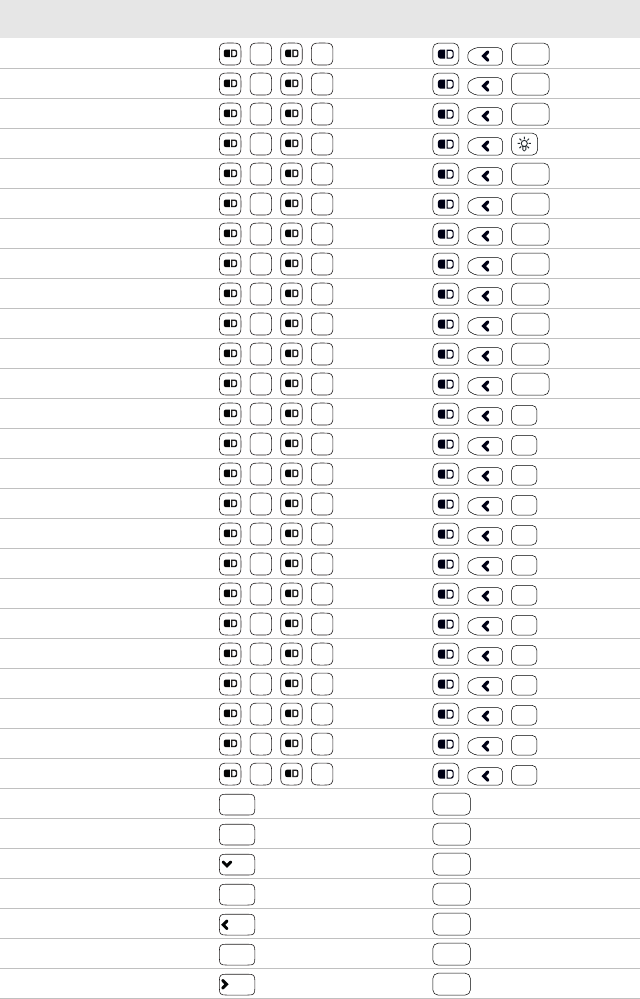
Appendix C — Keypads and Keystrokes
CK3 Mobile Computer User’s Manual 107
B
C
D
E
F
G
H
I
J
K
L
M
N
O
P
Q
R
S
T
U
V
W
X
Y
Z
0
1
2
3
4
5
6
Alphanumeric Characters (continued)
Character Alphanumeric Keypad Numeric Keypad
B
B
7
C
C
8
D
D
9
E
E
F
F
4
G
G
5
H
H
6
I
I
1
J
J
2
K
K
3
L
L
FldExit
M
M
0
N
N
.
O
O
F1
P
P
F2
F2
Q
Q
F3
R
R
F4
S
S
F5
F5
T
T
F6
U
U
F7
V
V
F8
F8
W
W
F9
F9
X
X
F10
Y
Y
F11
F11
Z
Z
F12
F12
0
0
1
1
2
2
3
3
4
4
5
5
6
6

Appendix C — Keypads and Keystrokes
108 CK3 Mobile Computer User’s Manual
7
8
9
Function Keys
Function Alphanumeric Keypad Numeric Keypad
F1
F2
F3
F4
F5
F6
F7
F8
F9
F10
F11
F12
F13
F14
F15
F16
F17
F18
F19
F20
F21
F22
F23
F24
Alphanumeric Characters (continued)
Character Alphanumeric Keypad Numeric Keypad
7
7
8
8
9
9
F1
F1
F1
F2
F2
F2
F3
F3
F3
F4
F4
F4
F5
F5
F5
E
F6
F
F7F7
G
F8
H
F9F9
I
F10
J
F11
K
F12F12
L
F1
F1
M
F2
F2
N
F3
F3
O
F4
F4
P
F5
F5
Q
F6
F6
R
F7
F7
S
F8
F8
T
F9
F9
U
F10
F10
V
F11
F11
W
F12
F12
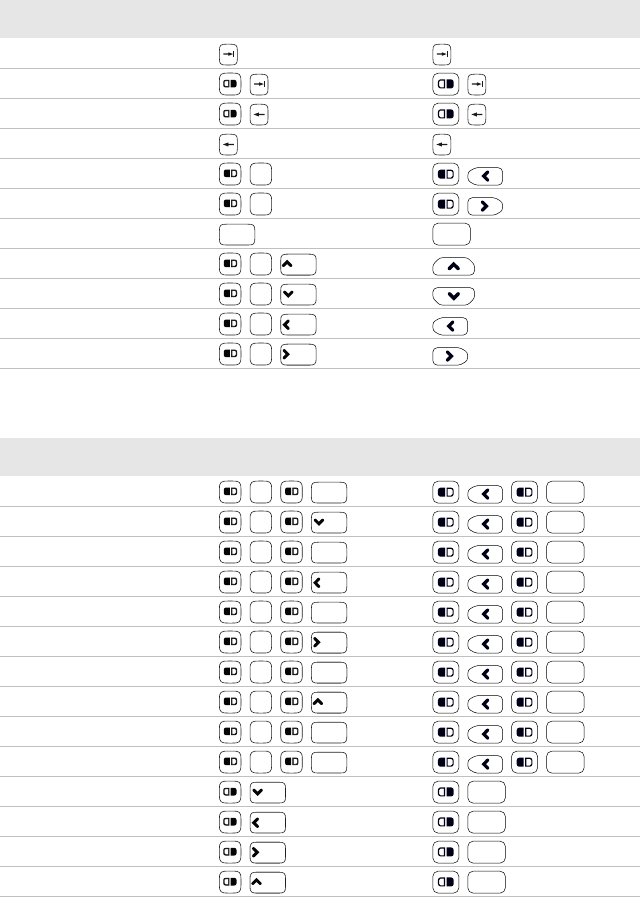
Appendix C — Keypads and Keystrokes
CK3 Mobile Computer User’s Manual 109
Special Functions
Function Alphanumeric Keypad Numeric Keypad
Forward Tab
Back Tab
Space
Backspace
Shift
Caps Lock
Field Exit
Up Arrow
Down Arrow
Left Arrow
Right Arrow
Hidden Characters and Functions
Character or Function Alphanumeric Keypad Numeric Keypad
!
@
#
$
%
^
&
*
(
)
OEM Down
CR Select
Select
Zoom
A
B
FldExit
FldExit
FldExit
A
1
8
8
A
2
A
4
A
1
6
6
A
1
1
A
2
2
A
3
3
A
4
4
A
5
5
A
1
6
6
A
1
7
7
A
1
8
8
8
A
9
9
A
0
0
2
2
4
4
1
6
6
1
8
8
Appendix C — Keypads and Keystrokes
110 CK3 Mobile Computer User’s Manual

111
IIndex
Index
112 CK3 Mobile Computer User’s Manual
Numerics
802.11b/g radio
communications,
configuring 29
connection information,
viewing 35
802.11d standard, described 2
802.1x security
configuring with Funk 41
configuring with Microsoft 45
A
AA20 audio adapter, described 90
AA21 RS-232 adapter, described 90
AA23 power adapter, described 91
AB17 and AB18 battery,
described 90
AB3 battery, charging with the IP30
and SR61 battery pack
adapter 91
AC20 quad charger
charging times 4
described 90
accessories, described 90
ActiveSync
connecting to a PC 26
installing applications 54
AD20 single dock
charging times 4
described 90
AD21 ethernet multidock
charging times 4
described 90
AD22 charge-only multidock
charging times 4
described 90
adjusting the speaker volume 10
AE33 vehicle battery adapter,
described 90
aligning the touch screen 13
alphanumeric keypad. See keypad.
applications
developing 52
installing
ActiveSync, using 54
Flash File Store 53
microSD card, using 53
non-volatile Flash File
Store 53
Object Store 53
using cab files 53
using FTP server 56
using microSD card 55
using SmartSystems
Foundation 54
using Wavelink Avalanche 56
launching automatically 59
area imager
reading distances 82,84
scanning bar codes 18–20
association label, connecting to a
Bluetooth scanner 31
audio adapter, AA20, described 90
audio device, Bluetooth,
connecting to 33
audio recordings, creating using
the PTT key 11
AutoRun
script commands 60
using to launch other
processes 60
AV10 vehicle dock
charging times 4
described 90
Avalanche Enabler, installing 56
Avalanche. See Wavelink Avalanche.
B
backlight settings, configuring 9
backup power, battery 3
bar code symbologies
default settings 96
enabled by default 16
supported 79
battery
AB17 and AB18, described 90
backup power 3
battery icons, described 6
charging times 4
checking the status 6
described 3
installing 5
maximizing battery life 5
Index
CK3 Mobile Computer User’s Manual 113
battery (continued)
removing 5
status LED 6
battery pack adapter, IP30 and
SR61, described 91
Bluetooth
audio device, connecting to 33
printer, connecting to 32
scanner
connecting to 31
passcode, default 31
Bluetooth Audio applet, described
33
Bluetooth radio
communications,
configuring 29
turning on 30
booting
clean 74
cold 73
troubleshooting 71
warm 73
C
cab files, using to install
applications 53
calibrating screen 13
calling product support 66
capitalizing characters 9
caps lock, enabling and disabling 9
center-decoding, scanning bar
codes 20
certificates
IAS server, importing from 48
loading 47
root, importing 48
characters
capitalizing 9
entering with
keystrokes 106–109
charging the battery 4
cigarette lighter adapter. See vehicle
battery adapter.
CK3 features 2
clean booting
described 74
troubleshooting 71
cold booting, described 73
color-coded keys, using 8
communications
802.11b/g, configuring 29
Bluetooth, configuring 29
Ethernet, configuring 33
serial, using 34
USB using 34
configuration
default settings 96–104
number, finding 66
configuring
backlight settings 9
network communications 28
parameters 27
remotely with SmartSystems
Foundation 28
settings 27
connecting to a PC 26
contacting Intermec by phone viii
D
default
bar code symbologies 16
configuration 96–104
developing applications 52
E
EA20X
performance, improving 19
reading distances 82
scanning bar codes 18
environmental specifications 78
errors, finding and solving 67–72
Ethernet communications,
configuring 33
EV12
reading distances 80
scanning bar codes 17
EX25
performance, improving 19
reading distances 84
extended range area imager
performance, improving 19
reading distances 82
scanning bar codes 18
Index
114 CK3 Mobile Computer User’s Manual
F
features of the CK3 2
Flash File Store, installing
applications to 53
FTP server
managing 56
using to install applications 56
Funk security
choosing 38
configuring
802.1x 41
LEAP 42
WEP 42
WPA 40
WPA2 40
WPA2-802.1x 39
WPA-802.1x 39
described 38
selecting a profile 39
G
green key, using 8
H
handle, scan, described 91
hardware for developing
applications 52
hidden characters, typing 109
holder, vehicle
described 91
for CK3 with IP30, described 91
holster, described 91
I
IAS server, certificate, importing 48
iConnect
FTP server, enabling 56
icon, illustrated 13
wireless connection, checking
status 34
icons
battery, described 6
screen, described 13
IDL (Intermec Developer Library),
developing applications 52
imager, area
center-decoding 20
extended range reading
distances 82
near-far range reading
distances 84
performance, improving 19
predefined modes 20
imager, linear
reading distances 80
scanning bar codes 17
installing the battery 5
InstallSelect
software components,
described 59
using to free up memory 57
Intermec
contact information ii
product support
calling 66
Knowledge Central web
site viii
support contact information viii
Intermec Settings
configuring CK3 27
navigating 28
IP30 and CK3 vehicle holder,
described 91
IP30 and SR61
battery pack adapter, described
91
ISpyWiFi
shortcut, creating 36
tabs, described 92
viewing radio connection
information 35
IVA, described 61
K
keypad
capitalizing characters 9
color-coded keys, using 8
hidden characters, typing 109
illustrated 7
keystrokes for entering
characters 106–109
options 79
troubleshooting 68
using the color-coded keys 8
Index
CK3 Mobile Computer User’s Manual 115
L
launching applications
automatically 59
LEAP security, configuring with
Funk 42
LEDs, status
described 15
illustrated 14
linear imager
reading distances 80
scanning bar codes 17
loading certificates 47
locked computer,
troubleshooting 69
M
manuals, downloading from web ix
maximizing battery life 5
memory
freeing up virtual for
applications 57
microSD card 53
non-volatile Flash File Store 53
Object Store or Flash File
Store 53
microSD card
installing 21
troubleshooting 68
upgrading CK3 62
using to install applications 55
Microsoft security
choosing 43
configuring 43–46
802.1x 45
WEP 46
WPA 44
WPA-802.1x 44
WPA-PSK 45
described 38
modifier keys, using 8
multidock
charge-only, AD22, described 90
ethernet, AD21, described 90
N
near-far range area imager
reading distances 84
scanning bar codes 19
network
communications, configuring
28
connection icon
illustrated 13
troubleshooting 70
non-volatile Flash File Store,
installing applications 53
numeric keypad. See keypad.
O
Object Store, installing
applications to 53
omnidirectional scanning 18
operating system
upgrading 61
version, finding 67
orange key, using 8
P
parameters, configuring 27
partnership, ActiveSync,
establishing 26
passcode, Bluetooth scanner
default 31
patents, list of x
PC, connecting to with ActiveSync
26
PEAP
choosing with 802.1x Funk
security 41
choosing with 802.1x Microsoft
security 46
choosing with WPA Funk
security 40
choosing with WPA Microsoft
security 44
persistent storage manager,
upgrading 61
physical specifications 78
power adapter, AA23, described 91
power button
described 9
troubleshooting 68
printer, Bluetooth, connecting
to 32
Index
116 CK3 Mobile Computer User’s Manual
problems, troubleshooting 67–72
product support
calling 66
Knowledge Central web site viii
profile, Funk security, selecting 39
PTT (Push To Talk),
described 10
Q
quad charger, AC20, described 90
R
radio
802.11b/g
communications,
configuring 29
connection information,
viewing 35
Bluetooth
communications,
configuring 29
turning on 30
reading distances
EA20X 82
EV12 80
EX25 84
recording audio, using the
PTT key 11
removing the battery 5
resetting the CK3 73
root certificate, importing 48
RS-232 adapter, AA21, described 90
S
safety icons vii
scan handle, described 91
scanner window, cleaning 76
scanners
Bluetooth
connecting to 31
passcode, default 31
supported 16
scanning
center decoding 20
omnidirectionally 18
troubleshooting 71,72
screen
aligning 13
cleaning 76
icons, described 13
specifications 78
touch, described 12
troubleshooting 69
SD card. See microSD card.
SDMMC Disk folder
creating with microSD card 53
troubleshooting 68
security
choosing between Microsoft and
Funk 38
configuring 37–46
Funk 39–43
Microsoft 43–46
disabling 49
Funk, selecting a profile 39
loading certificates 47
serial communications, using 34
settings
configuring
remotely with SmartSystems
Foundation 28
with Intermec Settings 27
default 96–104
single dock, AD20, described 90
SmartSystems Foundation
configuring CK3 remotely 28
Platform Bundle
finding version 67
upgrading with microSD
card 62
upgrading the CK3 63
using to install applications 54
snap-on adapter
AA20 audio adapter,
described 90
AA21 RS-232 adapter,
described 90
AA23 power adapter,
described 91
software
for developing applications 52
version, finding 67
speaker, adjusting the volume 10
Index
CK3 Mobile Computer User’s Manual 117
specifications, physical and
environmental 78
status LEDs
battery, described 6
described 15
illustrated 14
storage card folder, microSD
card 53
storage, increasing with microSD
card 21
support, contacting Intermec viii
suspend mode, described 9
symbologies. See bar code
symbologies.
T
technical support viii
TLS
choosing with 802.1x Microsoft
security 45
choosing with WPA Funk
security 40,42
choosing with WPA Microsoft
security 44
touch screen. See screen.
troubleshooting problems 67–72
TTLS
choosing with 802.1x Funk
security 41
choosing with WPA Funk
security 40
U
uninstalling the battery 5
upgrade files, downloading 61
upgrading
operating system 61
persistant storage manager 61
using microSD card 62
using SmartSystems console 63
USB communications, using 34
V
vehicle battery adapter, AE33,
described 90
vehicle dock, AV10, described 90
vehicle holder
described 91
for CK3 with IP30, described 91
virtual memory, freeing up 57
volume
adjusting 10
icon, illustrated 13
W
warm booting, described 73
warranty information vii
Wavelink Avalanche
Avalanche Enabler
installing 56
password 57
using to install applications 56
WEP security
configuring, Funk 42
configuring, Microsoft 46
WiFi communications
configuring 29
supported 2
will not boot from microSD
card 68
window, scanner, cleaning 76
wireless
audio device, connecting to 33
connection, check status with
iConnect 34
printer, connecting to 32
scanner, connecting to 31
security, configuring 37
Wireless Scanning Wizard,
connecting to a scanner 31
WPA security
configuring Funk 40
configuring with Microsoft 44
WPA2 security, configuring with
Funk 40
WPA2-802.1x security, configuring
with Funk 39
WPA-802.1x security
configuring with Funk 39
configuring with Microsoft 44
WPA-PSK security, configuring
with Microsoft 45
Index
118 CK3 Mobile Computer User’s Manual

Worldwide Headquarters
6001 36th Avenue West
Everett, Washington 98203
U.S.A.
tel 425.348.2600
fax 425.355.9551
w
ww.intermec.com
© 2008 Intermec Technologies
Corporation. All rights reserved.
CK3 Mobile Computer User’s Manual
*935-016-001*
P/N 935-016-001